

Writing Rubrics [Examples, Best Practices, & Free Templates]
Writing rubrics are essential tools for teachers.
Rubrics can improve both teaching and learning. This guide will explain writing rubrics, their benefits, and how to create and use them effectively.
What Is a Writing Rubric?
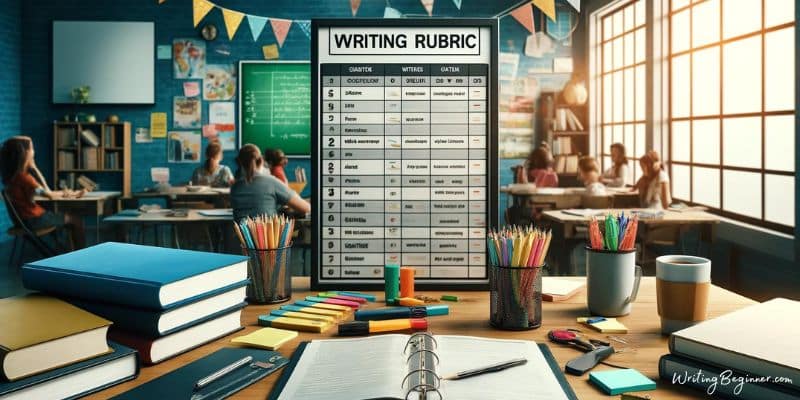
Table of Contents
A writing rubric is a scoring guide used to evaluate written work.
It lists criteria and describes levels of quality from excellent to poor. Rubrics provide a standardized way to assess writing.
They make expectations clear and grading consistent.
Key Components of a Writing Rubric
- Criteria : Specific aspects of writing being evaluated (e.g., grammar, organization).
- Descriptors : Detailed descriptions of what each level of performance looks like.
- Scoring Levels : Typically, a range (e.g., 1-4 or 1-6) showing levels of mastery.
Example Breakdown
| Criteria | 4 (Excellent) | 3 (Good) | 2 (Fair) | 1 (Poor) |
|---|---|---|---|---|
| Grammar | No errors | Few minor errors | Several errors | Many errors |
| Organization | Clear and logical | Mostly clear | Somewhat clear | Not clear |
| Content | Thorough and insightful | Good, but not thorough | Basic, lacks insight | Incomplete or off-topic |
Benefits of Using Writing Rubrics
Writing rubrics offer many advantages:
- Clarity : Rubrics clarify expectations for students. They know what is required for each level of performance.
- Consistency : Rubrics standardize grading. This ensures fairness and consistency across different students and assignments.
- Feedback : Rubrics provide detailed feedback. Students understand their strengths and areas for improvement.
- Efficiency : Rubrics streamline the grading process. Teachers can evaluate work more quickly and systematically.
- Self-Assessment : Students can use rubrics to self-assess. This promotes reflection and responsibility for their learning.
Examples of Writing Rubrics
Here are some examples of writing rubrics.
Narrative Writing Rubric
| Criteria | 4 (Excellent) | 3 (Good) | 2 (Fair) | 1 (Poor) |
|---|---|---|---|---|
| Story Elements | Well-developed | Developed, some details | Basic, missing details | Underdeveloped |
| Creativity | Highly creative | Creative | Some creativity | Lacks creativity |
| Grammar | No errors | Few minor errors | Several errors | Many errors |
| Organization | Clear and logical | Mostly clear | Somewhat clear | Not clear |
| Language Use | Rich and varied | Varied | Limited | Basic or inappropriate |
Persuasive Writing Rubric
| Criteria | 4 (Excellent) | 3 (Good) | 2 (Fair) | 1 (Poor) |
|---|---|---|---|---|
| Argument | Strong and convincing | Convincing, some gaps | Basic, lacks support | Weak or unsupported |
| Evidence | Strong and relevant | Relevant, but not strong | Some relevant, weak | Irrelevant or missing |
| Grammar | No errors | Few minor errors | Several errors | Many errors |
| Organization | Clear and logical | Mostly clear | Somewhat clear | Not clear |
| Language Use | Persuasive and engaging | Engaging | Somewhat engaging | Not engaging |
Best Practices for Creating Writing Rubrics
Let’s look at some best practices for creating useful writing rubrics.
1. Define Clear Criteria
Identify specific aspects of writing to evaluate. Be clear and precise.
The criteria should reflect the key components of the writing task. For example, for a narrative essay, criteria might include plot development, character depth, and use of descriptive language.
Clear criteria help students understand what is expected and allow teachers to provide targeted feedback.
Insider Tip : Collaborate with colleagues to establish consistent criteria across grade levels. This ensures uniformity in expectations and assessments.
2. Use Detailed Descriptors
Describe what each level of performance looks like.
This ensures transparency and clarity. Avoid vague language. Instead of saying “good,” describe what “good” entails. For example, “Few minor grammatical errors that do not impede readability.”
Detailed descriptors help students gauge their performance accurately.
Insider Tip : Use student work samples to illustrate each performance level. This provides concrete examples and helps students visualize expectations.
3. Involve Students
Involve students in the rubric creation process. This increases their understanding and buy-in.
Ask for their input on what they think is important in their writing.
This collaborative approach not only demystifies the grading process but also fosters a sense of ownership and responsibility in students.
Insider Tip : Conduct a workshop where students help create a rubric for an upcoming assignment. This interactive session can clarify doubts and make students more invested in their work.
4. Align with Objectives
Ensure the rubric aligns with learning objectives. This ensures relevance and focus.
If the objective is to enhance persuasive writing skills, the rubric should emphasize argument strength, evidence quality, and persuasive techniques.
Alignment ensures that the assessment directly supports instructional goals.
Insider Tip : Regularly revisit and update rubrics to reflect changes in curriculum and instructional priorities. This keeps the rubrics relevant and effective.
5. Review and Revise
Regularly review and revise rubrics. Ensure they remain accurate and effective.
Solicit feedback from students and colleagues. Continuous improvement of rubrics ensures they remain a valuable tool for both assessment and instruction.
Insider Tip : After using a rubric, take notes on its effectiveness. Were students confused by any criteria? Did the rubric cover all necessary aspects of the assignment? Use these observations to make adjustments.
6. Be Consistent
Use the rubric consistently across all assignments.
This ensures fairness and reliability. Consistency in applying the rubric helps build trust with students and maintains the integrity of the assessment process.
Insider Tip : Develop a grading checklist to accompany the rubric. This can help ensure that all criteria are consistently applied and none are overlooked during the grading process.
7. Provide Examples
Provide examples of each performance level.
This helps students understand expectations. Use annotated examples to show why a particular piece of writing meets a specific level.
This visual and practical demonstration can be more effective than descriptions alone.
Insider Tip : Create a portfolio of exemplar works for different assignments. This can be a valuable resource for both new and experienced teachers to standardize grading.
How to Use Writing Rubrics Effectively
Here is how to use writing rubrics like the pros.
1. Introduce Rubrics Early
Introduce rubrics at the beginning of the assignment.
Explain each criterion and performance level. This upfront clarity helps students understand what is expected and guides their work from the start.
Insider Tip : Conduct a rubric walkthrough session where you discuss each part of the rubric in detail. Allow students to ask questions and provide examples to illustrate each criterion.
2. Use Rubrics as a Teaching Tool
Use rubrics to teach writing skills. Discuss what constitutes good writing and why.
This can be an opportunity to reinforce lessons on grammar, organization, and other writing components.
Insider Tip : Pair the rubric with writing workshops. Use the rubric to critique sample essays and show students how to apply the rubric to improve their own writing.
3. Provide Feedback
Use the rubric to give detailed feedback. Highlight strengths and areas for improvement.
This targeted feedback helps students understand their performance and learn how to improve.
Insider Tip : Instead of just marking scores, add comments next to each criterion on the rubric. This personalized feedback can be more impactful and instructive for students.
4. Encourage Self-Assessment
Encourage students to use rubrics to self-assess.
This promotes reflection and growth. Before submitting their work, ask students to evaluate their own writing against the rubric.
This practice fosters self-awareness and critical thinking.
Insider Tip : Incorporate self-assessment as a mandatory step in the assignment process. Provide a simplified version of the rubric for students to use during self-assessment.
5. Use Rubrics for Peer Assessment
Use rubrics for peer assessment. This allows students to learn from each other.
Peer assessments can provide new perspectives and reinforce learning.
Insider Tip : Conduct a peer assessment workshop. Train students on how to use the rubric to evaluate each other’s work constructively. This can improve the quality of peer feedback.
6. Reflect and Improve
Reflect on the effectiveness of the rubric. Make adjustments as needed for future assignments.
Continuous reflection ensures that rubrics remain relevant and effective tools for assessment and learning.
Insider Tip : After an assignment, hold a debrief session with students to gather their feedback on the rubric. Use their insights to make improvements.
Check out this video about using writing rubrics:
Common Mistakes with Writing Rubrics
Creating and using writing rubrics can be incredibly effective, but there are common mistakes that can undermine their effectiveness.
Here are some pitfalls to avoid:
1. Vague Criteria
Vague criteria can confuse students and lead to inconsistent grading.
Ensure that each criterion is specific and clearly defined. Ambiguous terms like “good” or “satisfactory” should be replaced with concrete descriptions of what those levels of performance look like.
2. Overly Complex Rubrics
While detail is important, overly complex rubrics can be overwhelming for both students and teachers.
Too many criteria and performance levels can complicate the grading process and make it difficult for students to understand what is expected.
Keep rubrics concise and focused on the most important aspects of the assignment.
3. Inconsistent Application
Applying the rubric inconsistently can lead to unfair grading.
Ensure that you apply the rubric in the same way for all students and all assignments. Consistency builds trust and ensures that grades accurately reflect student performance.
4. Ignoring Student Input
Ignoring student input when creating rubrics can result in criteria that do not align with student understanding or priorities.
Involving students in the creation process can enhance their understanding and engagement with the rubric.
5. Failing to Update Rubrics
Rubrics should evolve to reflect changes in instructional goals and student needs.
Failing to update rubrics can result in outdated criteria that no longer align with current teaching objectives.
Regularly review and revise rubrics to keep them relevant and effective.
6. Lack of Examples
Without examples, students may struggle to understand the expectations for each performance level.
Providing annotated examples of work that meets each criterion can help students visualize what is required and guide their efforts more effectively.
7. Not Providing Feedback
Rubrics should be used as a tool for feedback, not just scoring.
Simply assigning a score without providing detailed feedback can leave students unclear about their strengths and areas for improvement.
Use the rubric to give comprehensive feedback that guides students’ growth.
8. Overlooking Self-Assessment and Peer Assessment
Self-assessment and peer assessment are valuable components of the learning process.
Overlooking these opportunities can limit students’ ability to reflect on their own work and learn from their peers.
Encourage students to use the rubric for self and peer assessment to deepen their understanding and enhance their skills.
What Is a Holistic Scoring Rubric for Writing?
A holistic scoring rubric for writing is a type of rubric that evaluates a piece of writing as a whole rather than breaking it down into separate criteria
This approach provides a single overall score based on the general impression of the writing’s quality and effectiveness.
Here’s a closer look at holistic scoring rubrics.
Key Features of Holistic Scoring Rubrics
- Single Overall Score : Assigns one score based on the overall quality of the writing.
- General Criteria : Focuses on the overall effectiveness, coherence, and impact of the writing.
- Descriptors : Uses broad descriptors for each score level to capture the general characteristics of the writing.
Example Holistic Scoring Rubric
| Score | Description |
|---|---|
| 5 | : Exceptionally clear, engaging, and well-organized writing. Demonstrates excellent control of language, grammar, and style. |
| 4 | : Clear and well-organized writing. Minor errors do not detract from the overall quality. Demonstrates good control of language and style. |
| 3 | : Satisfactory writing with some organizational issues. Contains a few errors that may distract but do not impede understanding. |
| 2 | : Basic writing that lacks organization and contains several errors. Demonstrates limited control of language and style. |
| 1 | : Unclear and poorly organized writing. Contains numerous errors that impede understanding. Demonstrates poor control of language and style. |
Advantages of Holistic Scoring Rubrics
- Efficiency : Faster to use because it involves a single overall judgment rather than multiple criteria.
- Flexibility : Allows for a more intuitive assessment of the writing’s overall impact and effectiveness.
- Comprehensiveness : Captures the overall quality of writing, considering all elements together.
Disadvantages of Holistic Scoring Rubrics
- Less Detailed Feedback : Provides a general score without specific feedback on individual aspects of writing.
- Subjectivity : Can be more subjective, as it relies on the assessor’s overall impression rather than specific criteria.
- Limited Diagnostic Use : Less useful for identifying specific areas of strength and weakness for instructional purposes.
When to Use Holistic Scoring Rubrics
- Quick Assessments : When a quick, overall evaluation is needed.
- Standardized Testing : Often used in standardized testing scenarios where consistency and efficiency are priorities.
- Initial Impressions : Useful for providing an initial overall impression before more detailed analysis.
Free Writing Rubric Templates
Feel free to use the following writing rubric templates.
You can easily copy and paste them into a Word Document. Please do credit this website on any written, printed, or published use.
Otherwise, go wild.
| Criteria | 4 (Excellent) | 3 (Good) | 2 (Fair) | 1 (Poor) |
|---|---|---|---|---|
| Well-developed, engaging, and clear plot, characters, and setting. | Developed plot, characters, and setting with some details missing. | Basic plot, characters, and setting; lacks details. | Underdeveloped plot, characters, and setting. | |
| Highly creative and original. | Creative with some originality. | Some creativity but lacks originality. | Lacks creativity and originality. | |
| No grammatical errors. | Few minor grammatical errors. | Several grammatical errors. | Numerous grammatical errors. | |
| Clear and logical structure. | Mostly clear structure. | Somewhat clear structure. | Lacks clear structure. | |
| Rich, varied, and appropriate language. | Varied and appropriate language. | Limited language variety. | Basic or inappropriate language. |
| Criteria | 4 (Excellent) | 3 (Good) | 2 (Fair) | 1 (Poor) |
|---|---|---|---|---|
| Strong, clear, and convincing argument. | Convincing argument with minor gaps. | Basic argument; lacks strong support. | Weak or unsupported argument. | |
| Strong, relevant, and well-integrated evidence. | Relevant evidence but not strong. | Some relevant evidence, but weak. | Irrelevant or missing evidence. | |
| No grammatical errors. | Few minor grammatical errors. | Several grammatical errors. | Numerous grammatical errors. | |
| Clear and logical structure. | Mostly clear structure. | Somewhat clear structure. | Lacks clear structure. | |
| Persuasive and engaging language. | Engaging language. | Somewhat engaging language. | Not engaging language. |
Expository Writing Rubric
| Criteria | 4 (Excellent) | 3 (Good) | 2 (Fair) | 1 (Poor) |
|---|---|---|---|---|
| Thorough, accurate, and insightful content. | Accurate content with some details missing. | Basic content; lacks depth. | Incomplete or inaccurate content. | |
| Clear and concise explanations. | Mostly clear explanations. | Somewhat clear explanations. | Unclear explanations. | |
| No grammatical errors. | Few minor grammatical errors. | Several grammatical errors. | Numerous grammatical errors. | |
| Clear and logical structure. | Mostly clear structure. | Somewhat clear structure. | Lacks clear structure. | |
| Precise and appropriate language. | Appropriate language. | Limited language variety. | Basic or inappropriate language. |
Descriptive Writing Rubric
| Criteria | 4 (Excellent) | 3 (Good) | 2 (Fair) | 1 (Poor) |
|---|---|---|---|---|
| Vivid and detailed imagery that engages the senses. | Detailed imagery with minor gaps. | Basic imagery; lacks vivid details. | Little to no imagery. | |
| Highly creative and original descriptions. | Creative with some originality. | Some creativity but lacks originality. | Lacks creativity and originality. | |
| No grammatical errors. | Few minor grammatical errors. | Several grammatical errors. | Numerous grammatical errors. | |
| Clear and logical structure. | Mostly clear structure. | Somewhat clear structure. | Lacks clear structure. | |
| Rich, varied, and appropriate language. | Varied and appropriate language. | Limited language variety. | Basic or inappropriate language. |
Analytical Writing Rubric
| Criteria | 4 (Excellent) | 3 (Good) | 2 (Fair) | 1 (Poor) |
|---|---|---|---|---|
| Insightful, thorough, and well-supported analysis. | Good analysis with some depth. | Basic analysis; lacks depth. | Weak or unsupported analysis. | |
| Strong, relevant, and well-integrated evidence. | Relevant evidence but not strong. | Some relevant evidence, but weak. | Irrelevant or missing evidence. | |
| No grammatical errors. | Few minor grammatical errors. | Several grammatical errors. | Numerous grammatical errors. | |
| Clear and logical structure. | Mostly clear structure. | Somewhat clear structure. | Lacks clear structure. | |
| Precise and appropriate language. | Appropriate language. | Limited language variety. | Basic or inappropriate language. |
Final Thoughts: Writing Rubrics
I have a lot more resources for teaching on this site.
Check out some of the blog posts I’ve listed below. I think you might enjoy them.
Read This Next:
- Narrative Writing Graphic Organizer [Guide + Free Templates]
- 100 Best A Words for Kids (+ How to Use Them)
- 100 Best B Words For Kids (+How to Teach Them)
- 100 Dictation Word Ideas for Students and Kids
- 50 Tricky Words to Pronounce and Spell (How to Teach Them)
- Grades 6-12
- School Leaders
Have you gotten your free poster delivered? ✨
15 Helpful Scoring Rubric Examples for All Grades and Subjects
In the end, they actually make grading easier.

When it comes to student assessment and evaluation, there are a lot of methods to consider. In some cases, testing is the best way to assess a student’s knowledge, and the answers are either right or wrong. But often, assessing a student’s performance is much less clear-cut. In these situations, a scoring rubric is often the way to go, especially if you’re using standards-based grading . Here’s what you need to know about this useful tool, along with lots of rubric examples to get you started.
What is a scoring rubric?
In the United States, a rubric is a guide that lays out the performance expectations for an assignment. It helps students understand what’s required of them, and guides teachers through the evaluation process. (Note that in other countries, the term “rubric” may instead refer to the set of instructions at the beginning of an exam. To avoid confusion, some people use the term “scoring rubric” instead.)
A rubric generally has three parts:
- Performance criteria: These are the various aspects on which the assignment will be evaluated. They should align with the desired learning outcomes for the assignment.
- Rating scale: This could be a number system (often 1 to 4) or words like “exceeds expectations, meets expectations, below expectations,” etc.
- Indicators: These describe the qualities needed to earn a specific rating for each of the performance criteria. The level of detail may vary depending on the assignment and the purpose of the rubric itself.
Rubrics take more time to develop up front, but they help ensure more consistent assessment, especially when the skills being assessed are more subjective. A well-developed rubric can actually save teachers a lot of time when it comes to grading. What’s more, sharing your scoring rubric with students in advance often helps improve performance . This way, students have a clear picture of what’s expected of them and what they need to do to achieve a specific grade or performance rating.
Learn more about why and how to use a rubric here.
Types of Rubric
There are three basic rubric categories, each with its own purpose.
Holistic Rubric

Source: Cambrian College
This type of rubric combines all the scoring criteria in a single scale. They’re quick to create and use, but they have drawbacks. If a student’s work spans different levels, it can be difficult to decide which score to assign. They also make it harder to provide feedback on specific aspects.
Traditional letter grades are a type of holistic rubric. So are the popular “hamburger rubric” and “ cupcake rubric ” examples. Learn more about holistic rubrics here.
Analytic Rubric

Source: University of Nebraska
Analytic rubrics are much more complex and generally take a great deal more time up front to design. They include specific details of the expected learning outcomes, and descriptions of what criteria are required to meet various performance ratings in each. Each rating is assigned a point value, and the total number of points earned determines the overall grade for the assignment.
Though they’re more time-intensive to create, analytic rubrics actually save time while grading. Teachers can simply circle or highlight any relevant phrases in each rating, and add a comment or two if needed. They also help ensure consistency in grading, and make it much easier for students to understand what’s expected of them.
Learn more about analytic rubrics here.
Developmental Rubric

Source: Deb’s Data Digest
A developmental rubric is a type of analytic rubric, but it’s used to assess progress along the way rather than determining a final score on an assignment. The details in these rubrics help students understand their achievements, as well as highlight the specific skills they still need to improve.
Developmental rubrics are essentially a subset of analytic rubrics. They leave off the point values, though, and focus instead on giving feedback using the criteria and indicators of performance.
Learn how to use developmental rubrics here.
Ready to create your own rubrics? Find general tips on designing rubrics here. Then, check out these examples across all grades and subjects to inspire you.
Elementary School Rubric Examples
These elementary school rubric examples come from real teachers who use them with their students. Adapt them to fit your needs and grade level.
Reading Fluency Rubric

You can use this one as an analytic rubric by counting up points to earn a final score, or just to provide developmental feedback. There’s a second rubric page available specifically to assess prosody (reading with expression).
Learn more: Teacher Thrive
Reading Comprehension Rubric

The nice thing about this rubric is that you can use it at any grade level, for any text. If you like this style, you can get a reading fluency rubric here too.
Learn more: Pawprints Resource Center
Written Response Rubric

Rubrics aren’t just for huge projects. They can also help kids work on very specific skills, like this one for improving written responses on assessments.
Learn more: Dianna Radcliffe: Teaching Upper Elementary and More
Interactive Notebook Rubric

If you use interactive notebooks as a learning tool , this rubric can help kids stay on track and meet your expectations.
Learn more: Classroom Nook
Project Rubric

Use this simple rubric as it is, or tweak it to include more specific indicators for the project you have in mind.
Learn more: Tales of a Title One Teacher
Behavior Rubric

Developmental rubrics are perfect for assessing behavior and helping students identify opportunities for improvement. Send these home regularly to keep parents in the loop.
Learn more: Teachers.net Gazette
Middle School Rubric Examples
In middle school, use rubrics to offer detailed feedback on projects, presentations, and more. Be sure to share them with students in advance, and encourage them to use them as they work so they’ll know if they’re meeting expectations.
Argumentative Writing Rubric

Argumentative writing is a part of language arts, social studies, science, and more. That makes this rubric especially useful.
Learn more: Dr. Caitlyn Tucker
Role-Play Rubric

Role-plays can be really useful when teaching social and critical thinking skills, but it’s hard to assess them. Try a rubric like this one to evaluate and provide useful feedback.
Learn more: A Question of Influence
Art Project Rubric

Art is one of those subjects where grading can feel very subjective. Bring some objectivity to the process with a rubric like this.
Source: Art Ed Guru
Diorama Project Rubric

You can use diorama projects in almost any subject, and they’re a great chance to encourage creativity. Simplify the grading process and help kids know how to make their projects shine with this scoring rubric.
Learn more: Historyourstory.com
Oral Presentation Rubric

Rubrics are terrific for grading presentations, since you can include a variety of skills and other criteria. Consider letting students use a rubric like this to offer peer feedback too.
Learn more: Bright Hub Education
High School Rubric Examples
In high school, it’s important to include your grading rubrics when you give assignments like presentations, research projects, or essays. Kids who go on to college will definitely encounter rubrics, so helping them become familiar with them now will help in the future.
Presentation Rubric

Analyze a student’s presentation both for content and communication skills with a rubric like this one. If needed, create a separate one for content knowledge with even more criteria and indicators.
Learn more: Michael A. Pena Jr.
Debate Rubric

Debate is a valuable learning tool that encourages critical thinking and oral communication skills. This rubric can help you assess those skills objectively.
Learn more: Education World
Project-Based Learning Rubric

Implementing project-based learning can be time-intensive, but the payoffs are worth it. Try this rubric to make student expectations clear and end-of-project assessment easier.
Learn more: Free Technology for Teachers
100-Point Essay Rubric

Need an easy way to convert a scoring rubric to a letter grade? This example for essay writing earns students a final score out of 100 points.
Learn more: Learn for Your Life
Drama Performance Rubric

If you’re unsure how to grade a student’s participation and performance in drama class, consider this example. It offers lots of objective criteria and indicators to evaluate.
Learn more: Chase March
How do you use rubrics in your classroom? Come share your thoughts and exchange ideas in the WeAreTeachers HELPLINE group on Facebook .
Plus, 25 of the best alternative assessment ideas ..

You Might Also Like

25 Creative Activities and Ideas For Learning Shapes
Triangles, circles, and squares... oh, my! Continue Reading
Copyright © 2024. All rights reserved. 5335 Gate Parkway, Jacksonville, FL 32256
Rubric Best Practices, Examples, and Templates
A rubric is a scoring tool that identifies the different criteria relevant to an assignment, assessment, or learning outcome and states the possible levels of achievement in a specific, clear, and objective way. Use rubrics to assess project-based student work including essays, group projects, creative endeavors, and oral presentations.
Rubrics can help instructors communicate expectations to students and assess student work fairly, consistently and efficiently. Rubrics can provide students with informative feedback on their strengths and weaknesses so that they can reflect on their performance and work on areas that need improvement.
How to Get Started
Best practices, moodle how-to guides.
- Workshop Recording (Spring 2024)
- Workshop Registration
Step 1: Analyze the assignment
The first step in the rubric creation process is to analyze the assignment or assessment for which you are creating a rubric. To do this, consider the following questions:
- What is the purpose of the assignment and your feedback? What do you want students to demonstrate through the completion of this assignment (i.e. what are the learning objectives measured by it)? Is it a summative assessment, or will students use the feedback to create an improved product?
- Does the assignment break down into different or smaller tasks? Are these tasks equally important as the main assignment?
- What would an “excellent” assignment look like? An “acceptable” assignment? One that still needs major work?
- How detailed do you want the feedback you give students to be? Do you want/need to give them a grade?
Step 2: Decide what kind of rubric you will use
Types of rubrics: holistic, analytic/descriptive, single-point
Holistic Rubric. A holistic rubric includes all the criteria (such as clarity, organization, mechanics, etc.) to be considered together and included in a single evaluation. With a holistic rubric, the rater or grader assigns a single score based on an overall judgment of the student’s work, using descriptions of each performance level to assign the score.
Advantages of holistic rubrics:
- Can p lace an emphasis on what learners can demonstrate rather than what they cannot
- Save grader time by minimizing the number of evaluations to be made for each student
- Can be used consistently across raters, provided they have all been trained
Disadvantages of holistic rubrics:
- Provide less specific feedback than analytic/descriptive rubrics
- Can be difficult to choose a score when a student’s work is at varying levels across the criteria
- Any weighting of c riteria cannot be indicated in the rubric
Analytic/Descriptive Rubric . An analytic or descriptive rubric often takes the form of a table with the criteria listed in the left column and with levels of performance listed across the top row. Each cell contains a description of what the specified criterion looks like at a given level of performance. Each of the criteria is scored individually.
Advantages of analytic rubrics:
- Provide detailed feedback on areas of strength or weakness
- Each criterion can be weighted to reflect its relative importance
Disadvantages of analytic rubrics:
- More time-consuming to create and use than a holistic rubric
- May not be used consistently across raters unless the cells are well defined
- May result in giving less personalized feedback
Single-Point Rubric . A single-point rubric is breaks down the components of an assignment into different criteria, but instead of describing different levels of performance, only the “proficient” level is described. Feedback space is provided for instructors to give individualized comments to help students improve and/or show where they excelled beyond the proficiency descriptors.
Advantages of single-point rubrics:
- Easier to create than an analytic/descriptive rubric
- Perhaps more likely that students will read the descriptors
- Areas of concern and excellence are open-ended
- May removes a focus on the grade/points
- May increase student creativity in project-based assignments
Disadvantage of analytic rubrics: Requires more work for instructors writing feedback
Step 3 (Optional): Look for templates and examples.
You might Google, “Rubric for persuasive essay at the college level” and see if there are any publicly available examples to start from. Ask your colleagues if they have used a rubric for a similar assignment. Some examples are also available at the end of this article. These rubrics can be a great starting point for you, but consider steps 3, 4, and 5 below to ensure that the rubric matches your assignment description, learning objectives and expectations.
Step 4: Define the assignment criteria
Make a list of the knowledge and skills are you measuring with the assignment/assessment Refer to your stated learning objectives, the assignment instructions, past examples of student work, etc. for help.
Helpful strategies for defining grading criteria:
- Collaborate with co-instructors, teaching assistants, and other colleagues
- Brainstorm and discuss with students
- Can they be observed and measured?
- Are they important and essential?
- Are they distinct from other criteria?
- Are they phrased in precise, unambiguous language?
- Revise the criteria as needed
- Consider whether some are more important than others, and how you will weight them.
Step 5: Design the rating scale
Most ratings scales include between 3 and 5 levels. Consider the following questions when designing your rating scale:
- Given what students are able to demonstrate in this assignment/assessment, what are the possible levels of achievement?
- How many levels would you like to include (more levels means more detailed descriptions)
- Will you use numbers and/or descriptive labels for each level of performance? (for example 5, 4, 3, 2, 1 and/or Exceeds expectations, Accomplished, Proficient, Developing, Beginning, etc.)
- Don’t use too many columns, and recognize that some criteria can have more columns that others . The rubric needs to be comprehensible and organized. Pick the right amount of columns so that the criteria flow logically and naturally across levels.
Step 6: Write descriptions for each level of the rating scale
Artificial Intelligence tools like Chat GPT have proven to be useful tools for creating a rubric. You will want to engineer your prompt that you provide the AI assistant to ensure you get what you want. For example, you might provide the assignment description, the criteria you feel are important, and the number of levels of performance you want in your prompt. Use the results as a starting point, and adjust the descriptions as needed.
Building a rubric from scratch
For a single-point rubric , describe what would be considered “proficient,” i.e. B-level work, and provide that description. You might also include suggestions for students outside of the actual rubric about how they might surpass proficient-level work.
For analytic and holistic rubrics , c reate statements of expected performance at each level of the rubric.
- Consider what descriptor is appropriate for each criteria, e.g., presence vs absence, complete vs incomplete, many vs none, major vs minor, consistent vs inconsistent, always vs never. If you have an indicator described in one level, it will need to be described in each level.
- You might start with the top/exemplary level. What does it look like when a student has achieved excellence for each/every criterion? Then, look at the “bottom” level. What does it look like when a student has not achieved the learning goals in any way? Then, complete the in-between levels.
- For an analytic rubric , do this for each particular criterion of the rubric so that every cell in the table is filled. These descriptions help students understand your expectations and their performance in regard to those expectations.
Well-written descriptions:
- Describe observable and measurable behavior
- Use parallel language across the scale
- Indicate the degree to which the standards are met
Step 7: Create your rubric
Create your rubric in a table or spreadsheet in Word, Google Docs, Sheets, etc., and then transfer it by typing it into Moodle. You can also use online tools to create the rubric, but you will still have to type the criteria, indicators, levels, etc., into Moodle. Rubric creators: Rubistar , iRubric
Step 8: Pilot-test your rubric
Prior to implementing your rubric on a live course, obtain feedback from:
- Teacher assistants
Try out your new rubric on a sample of student work. After you pilot-test your rubric, analyze the results to consider its effectiveness and revise accordingly.
- Limit the rubric to a single page for reading and grading ease
- Use parallel language . Use similar language and syntax/wording from column to column. Make sure that the rubric can be easily read from left to right or vice versa.
- Use student-friendly language . Make sure the language is learning-level appropriate. If you use academic language or concepts, you will need to teach those concepts.
- Share and discuss the rubric with your students . Students should understand that the rubric is there to help them learn, reflect, and self-assess. If students use a rubric, they will understand the expectations and their relevance to learning.
- Consider scalability and reusability of rubrics. Create rubric templates that you can alter as needed for multiple assignments.
- Maximize the descriptiveness of your language. Avoid words like “good” and “excellent.” For example, instead of saying, “uses excellent sources,” you might describe what makes a resource excellent so that students will know. You might also consider reducing the reliance on quantity, such as a number of allowable misspelled words. Focus instead, for example, on how distracting any spelling errors are.
Example of an analytic rubric for a final paper
| Above Average (4) | Sufficient (3) | Developing (2) | Needs improvement (1) | |
|---|---|---|---|---|
| (Thesis supported by relevant information and ideas | The central purpose of the student work is clear and supporting ideas always are always well-focused. Details are relevant, enrich the work. | The central purpose of the student work is clear and ideas are almost always focused in a way that supports the thesis. Relevant details illustrate the author’s ideas. | The central purpose of the student work is identified. Ideas are mostly focused in a way that supports the thesis. | The purpose of the student work is not well-defined. A number of central ideas do not support the thesis. Thoughts appear disconnected. |
| (Sequencing of elements/ ideas) | Information and ideas are presented in a logical sequence which flows naturally and is engaging to the audience. | Information and ideas are presented in a logical sequence which is followed by the reader with little or no difficulty. | Information and ideas are presented in an order that the audience can mostly follow. | Information and ideas are poorly sequenced. The audience has difficulty following the thread of thought. |
| (Correctness of grammar and spelling) | Minimal to no distracting errors in grammar and spelling. | The readability of the work is only slightly interrupted by spelling and/or grammatical errors. | Grammatical and/or spelling errors distract from the work. | The readability of the work is seriously hampered by spelling and/or grammatical errors. |
Example of a holistic rubric for a final paper
| The audience is able to easily identify the central message of the work and is engaged by the paper’s clear focus and relevant details. Information is presented logically and naturally. There are minimal to no distracting errors in grammar and spelling. : The audience is easily able to identify the focus of the student work which is supported by relevant ideas and supporting details. Information is presented in a logical manner that is easily followed. The readability of the work is only slightly interrupted by errors. : The audience can identify the central purpose of the student work without little difficulty and supporting ideas are present and clear. The information is presented in an orderly fashion that can be followed with little difficulty. Grammatical and spelling errors distract from the work. : The audience cannot clearly or easily identify the central ideas or purpose of the student work. Information is presented in a disorganized fashion causing the audience to have difficulty following the author’s ideas. The readability of the work is seriously hampered by errors. |
Single-Point Rubric
| Advanced (evidence of exceeding standards) | Criteria described a proficient level | Concerns (things that need work) |
|---|---|---|
| Criteria #1: Description reflecting achievement of proficient level of performance | ||
| Criteria #2: Description reflecting achievement of proficient level of performance | ||
| Criteria #3: Description reflecting achievement of proficient level of performance | ||
| Criteria #4: Description reflecting achievement of proficient level of performance | ||
| 90-100 points | 80-90 points | <80 points |
More examples:
- Single Point Rubric Template ( variation )
- Analytic Rubric Template make a copy to edit
- A Rubric for Rubrics
- Bank of Online Discussion Rubrics in different formats
- Mathematical Presentations Descriptive Rubric
- Math Proof Assessment Rubric
- Kansas State Sample Rubrics
- Design Single Point Rubric
Technology Tools: Rubrics in Moodle
- Moodle Docs: Rubrics
- Moodle Docs: Grading Guide (use for single-point rubrics)
Tools with rubrics (other than Moodle)
- Google Assignments
- Turnitin Assignments: Rubric or Grading Form
Other resources
- DePaul University (n.d.). Rubrics .
- Gonzalez, J. (2014). Know your terms: Holistic, Analytic, and Single-Point Rubrics . Cult of Pedagogy.
- Goodrich, H. (1996). Understanding rubrics . Teaching for Authentic Student Performance, 54 (4), 14-17. Retrieved from
- Miller, A. (2012). Tame the beast: tips for designing and using rubrics.
- Ragupathi, K., Lee, A. (2020). Beyond Fairness and Consistency in Grading: The Role of Rubrics in Higher Education. In: Sanger, C., Gleason, N. (eds) Diversity and Inclusion in Global Higher Education. Palgrave Macmillan, Singapore.
- Generating Ideas
- Drafting and Revision
- Sources and Evidence
- Style and Grammar
- Specific to Creative Arts
- Specific to Humanities
- Specific to Sciences
- Specific to Social Sciences
- CVs, Résumés and Cover Letters
- Graduate School Applications
- Other Resources
- Hiatt Career Center
- University Writing Center
- Classroom Materials
- Course and Assignment Design
- UWP Instructor Resources
- Writing Intensive Requirement
- Criteria and Learning Goals
- Course Application for Instructors
- FAQ for Instructors
- FAQ for Students
- Journals on Writing Research and Pedagogy
- University Writing Program
- Degree Programs
- Graduate Programs
- Brandeis Online
- Summer Programs
- Undergraduate Admissions
- Graduate Admissions
- Financial Aid
- Summer School
- Centers and Institutes
- Funding Resources
- Housing/Community Living
- Clubs and Organizations
- Community Service
- Brandeis Arts Engagement
- Rose Art Museum
- Our Jewish Roots
- Mission and Diversity Statements
- Administration
- Faculty & Staff
- Alumni & Friends
- Parents & Families
- Campus Calendar
- Directories
- New Students
- Shuttle Schedules
- Support at Brandeis
Writing Resources
Using rubrics: tips and examples.
Rubrics are a tool for effective assessment of student work. A rubric identifies specific expectations from a given assignment, as well as how the successful completion of these elements contributes to a grade.
For instructors, rubrics :
- Help the grading / feedback reflect the assignment / class goals
- Remove bias from grading (including across graders / TAs)
For students, rubrics :
- Ensure students know the expectations of an assignment(s) rubrics should be shared with students in advance
- Clearly justify grades for students
Rubrics can be used to evaluate progress, as well as to assess final products and assign grades. There are different types of rubrics, depending on the needs of the assignment:
Checklist Rubrics
Checklist rubrics assess completion of the parts of an assignment. The student is not assessed on how well each element is executed, but just on completion. Checklists can be done by the instructor, but can also be done by students themselves to self-assess their progress/product.An instructor can choose to give partial credit if an element of the assignment is partially completed. For example, for the UWS proposal assignment, a checklist rubric may look like this:
Proposal Element (completed/not completed):
- Introduction (1 paragraph)
- Literature Review (~2 pages)
- Library Research Plan (~1 page)
- Motive (1 paragraph)
- Weekly Timeline
- Annotated Bibliography (minimum of 3 sources)
An instructor can choose to give partial credit if an element of the assignment is partially completed.
Narrative / Holistic Rubrics
Narrative/holistic rubrics provide overall descriptions of [ insert text here ]
For example, this rubric refers to an assignment where students contributed to an online discussion board. As you can see, the assessment can be indicated in various ways—as a letter grade, as a descriptive word or phrase, or as a numerical rating. The rubric then shows a description of the expectations for that grade. To create this for a specific assignment, the instructor would consider what a submission that earned an A should look like, versus one that earned a B, C, etc. The instructor would then write detailed descriptions of what qualities a student would have to demonstrate in order to earn an A, B, C, etc.
A — Outstanding — (90-100) . Student created an original post that was highly insightful and which responded thoroughly to all parts of the prompt. The response effectively utilized a variety of evidence from the literary readings for the week, directly referencing the texts at least three times. Additionally, the student responded to peers' posts with a high degree of professionalism in interaction, grammar/mechanics, and spelling.
B — Very Good — (81-99) . Student created an original post that was insightful and responded to all or most parts of the prompt. The response utilized a variety of evidence from the text as well, though there may have been room for more and/or further explanation. Additionally, the student responded to peers' posts with a good degree of professionalism in interaction, grammar/mechanics, and spelling.
C — Average — (71-79) . Student created an original post that was at times insightful, though lacking in substantial well-explained evidence and/or which was at times off-topic from the prompt. Responses to peers were attempted, though these responses were lacking in insightful observation and/or had errors/lapses in professional interaction, grammar/mechanics, and spelling.
D — Needs Improvement — (60-69) . Student created an original post which did not effectively address the prompt and/or which was lacking in substantial evidence from the text. Responses to peers were incomplete or insubstantial with numerous errors/lapses in professional interaction, grammar/mechanics, and spelling.
F — Does not Meet Expectations — (59 and below) . Student created an original post which was too brief, did not respond to the prompt, and was lacking in substantial evidence from the text. Missing or overly brief responses to peers with errors/lapses in professional interaction, grammar/mechanics, and spelling.
Source: Virginia Commonwealth University
Narrative/Holistic Rubrics can be easier for instructors to create and use. However, for students, these sorts of rubrics often provide less specific feedback. A student may not know where exactly their writing fails to meet expectations. Narrative/holistic rubrics thus should be used in tandem with specific comments that articulate where the student needs improvement. Often, when an instructor is using a narrative/holistic rubric, there is a sort of analytical rubric (see below) going on behind the scenes, which helps inform the final grade. This behind-the-scenes thinking should be communicated to students.
Analytical / Developmental Rubrics
Similar to holistic rubrics but they break down the elements of the assignment into pieces. The benefit of this approach is that students see exactly where they are and are not succeeding with their writing. These rubrics can be time consuming to produce, but are effective in both communicating expectations and justifying grades. Some instructors opt to return each writing assignment with the rubric attached, highlighted or otherwise marked to show progress. Other instructors may opt to use detailed marginal and block comments to refer to the elements of the rubric.
Assignment Elements
THESIS A (Exceeding Standard) : The major claim of the essay is complex, insightful, and unexpected. B (Proficient) : The major claim is clear and arguable but lacks complexity or is too narrow in scope. C (Progressing) : The major claim of the essay is weak, i.e., vague, simple, or obvious. D (Not meeting standard) : The major claim is missing or unclear.
EVIDENCE A : Strong evidence is used in supportive and creative ways. B : Most ideas are supported by evidence, but not the best evidence. C : Evidence may be lacking or irrelevant. D : There is little to no appropriate evidence.
STRUCTURE A : Ideas develop over the course of the essay. B : The argument is mostly logical and structured. C : The argument does not develop over the course of the essay. D : Argument shows no clear structure.
REVISION A : Extensive & effective revision beyond instructor’s comments. B : Extensive revision. C : Some evidence of revision. D : Little evidence of revision.
Some instructors opt to return each writing assignment with the rubric attached, highlighted or otherwise marked to show progress. Other instructors may opt to use detailed marginal and block comments to refer to the elements of the rubric.
Elissa Jacobs and Paige Eggebrecht
- Resources for Students
- Research and Pedagogy
Rubric Design
Main navigation, articulating your assessment values.
Reading, commenting on, and then assigning a grade to a piece of student writing requires intense attention and difficult judgment calls. Some faculty dread “the stack.” Students may share the faculty’s dim view of writing assessment, perceiving it as highly subjective. They wonder why one faculty member values evidence and correctness before all else, while another seeks a vaguely defined originality.
Writing rubrics can help address the concerns of both faculty and students by making writing assessment more efficient, consistent, and public. Whether it is called a grading rubric, a grading sheet, or a scoring guide, a writing assignment rubric lists criteria by which the writing is graded.
Why create a writing rubric?
- It makes your tacit rhetorical knowledge explicit
- It articulates community- and discipline-specific standards of excellence
- It links the grade you give the assignment to the criteria
- It can make your grading more efficient, consistent, and fair as you can read and comment with your criteria in mind
- It can help you reverse engineer your course: once you have the rubrics created, you can align your readings, activities, and lectures with the rubrics to set your students up for success
- It can help your students produce writing that you look forward to reading

How to create a writing rubric
Create a rubric at the same time you create the assignment. It will help you explain to the students what your goals are for the assignment.
- Consider your purpose: do you need a rubric that addresses the standards for all the writing in the course? Or do you need to address the writing requirements and standards for just one assignment? Task-specific rubrics are written to help teachers assess individual assignments or genres, whereas generic rubrics are written to help teachers assess multiple assignments.
- Begin by listing the important qualities of the writing that will be produced in response to a particular assignment. It may be helpful to have several examples of excellent versions of the assignment in front of you: what writing elements do they all have in common? Among other things, these may include features of the argument, such as a main claim or thesis; use and presentation of sources, including visuals; and formatting guidelines such as the requirement of a works cited.
- Then consider how the criteria will be weighted in grading. Perhaps all criteria are equally important, or perhaps there are two or three that all students must achieve to earn a passing grade. Decide what best fits the class and requirements of the assignment.
Consider involving students in Steps 2 and 3. A class session devoted to developing a rubric can provoke many important discussions about the ways the features of the language serve the purpose of the writing. And when students themselves work to describe the writing they are expected to produce, they are more likely to achieve it.
At this point, you will need to decide if you want to create a holistic or an analytic rubric. There is much debate about these two approaches to assessment.
Comparing Holistic and Analytic Rubrics
Holistic scoring .
Holistic scoring aims to rate overall proficiency in a given student writing sample. It is often used in large-scale writing program assessment and impromptu classroom writing for diagnostic purposes.
General tenets to holistic scoring:
- Responding to drafts is part of evaluation
- Responses do not focus on grammar and mechanics during drafting and there is little correction
- Marginal comments are kept to 2-3 per page with summative comments at end
- End commentary attends to students’ overall performance across learning objectives as articulated in the assignment
- Response language aims to foster students’ self-assessment
Holistic rubrics emphasize what students do well and generally increase efficiency; they may also be more valid because scoring includes authentic, personal reaction of the reader. But holistic sores won’t tell a student how they’ve progressed relative to previous assignments and may be rater-dependent, reducing reliability. (For a summary of advantages and disadvantages of holistic scoring, see Becker, 2011, p. 116.)
Here is an example of a partial holistic rubric:
Summary meets all the criteria. The writer understands the article thoroughly. The main points in the article appear in the summary with all main points proportionately developed. The summary should be as comprehensive as possible and should be as comprehensive as possible and should read smoothly, with appropriate transitions between ideas. Sentences should be clear, without vagueness or ambiguity and without grammatical or mechanical errors.
A complete holistic rubric for a research paper (authored by Jonah Willihnganz) can be downloaded here.
Analytic Scoring
Analytic scoring makes explicit the contribution to the final grade of each element of writing. For example, an instructor may choose to give 30 points for an essay whose ideas are sufficiently complex, that marshals good reasons in support of a thesis, and whose argument is logical; and 20 points for well-constructed sentences and careful copy editing.
General tenets to analytic scoring:
- Reflect emphases in your teaching and communicate the learning goals for the course
- Emphasize student performance across criterion, which are established as central to the assignment in advance, usually on an assignment sheet
- Typically take a quantitative approach, providing a scaled set of points for each criterion
- Make the analytic framework available to students before they write
Advantages of an analytic rubric include ease of training raters and improved reliability. Meanwhile, writers often can more easily diagnose the strengths and weaknesses of their work. But analytic rubrics can be time-consuming to produce, and raters may judge the writing holistically anyway. Moreover, many readers believe that writing traits cannot be separated. (For a summary of the advantages and disadvantages of analytic scoring, see Becker, 2011, p. 115.)
For example, a partial analytic rubric for a single trait, “addresses a significant issue”:
- Excellent: Elegantly establishes the current problem, why it matters, to whom
- Above Average: Identifies the problem; explains why it matters and to whom
- Competent: Describes topic but relevance unclear or cursory
- Developing: Unclear issue and relevance
A complete analytic rubric for a research paper can be downloaded here. In WIM courses, this language should be revised to name specific disciplinary conventions.
Whichever type of rubric you write, your goal is to avoid pushing students into prescriptive formulas and limiting thinking (e.g., “each paragraph has five sentences”). By carefully describing the writing you want to read, you give students a clear target, and, as Ed White puts it, “describe the ongoing work of the class” (75).
Writing rubrics contribute meaningfully to the teaching of writing. Think of them as a coaching aide. In class and in conferences, you can use the language of the rubric to help you move past generic statements about what makes good writing good to statements about what constitutes success on the assignment and in the genre or discourse community. The rubric articulates what you are asking students to produce on the page; once that work is accomplished, you can turn your attention to explaining how students can achieve it.
Works Cited
Becker, Anthony. “Examining Rubrics Used to Measure Writing Performance in U.S. Intensive English Programs.” The CATESOL Journal 22.1 (2010/2011):113-30. Web.
White, Edward M. Teaching and Assessing Writing . Proquest Info and Learning, 1985. Print.
Further Resources
CCCC Committee on Assessment. “Writing Assessment: A Position Statement.” November 2006 (Revised March 2009). Conference on College Composition and Communication. Web.
Gallagher, Chris W. “Assess Locally, Validate Globally: Heuristics for Validating Local Writing Assessments.” Writing Program Administration 34.1 (2010): 10-32. Web.
Huot, Brian. (Re)Articulating Writing Assessment for Teaching and Learning. Logan: Utah State UP, 2002. Print.
Kelly-Reilly, Diane, and Peggy O’Neil, eds. Journal of Writing Assessment. Web.
McKee, Heidi A., and Dànielle Nicole DeVoss DeVoss, Eds. Digital Writing Assessment & Evaluation. Logan, UT: Computers and Composition Digital Press/Utah State University Press, 2013. Web.
O’Neill, Peggy, Cindy Moore, and Brian Huot. A Guide to College Writing Assessment . Logan: Utah State UP, 2009. Print.
Sommers, Nancy. Responding to Student Writers . Macmillan Higher Education, 2013.
Straub, Richard. “Responding, Really Responding to Other Students’ Writing.” The Subject is Writing: Essays by Teachers and Students. Ed. Wendy Bishop. Boynton/Cook, 1999. Web.
White, Edward M., and Cassie A. Wright. Assigning, Responding, Evaluating: A Writing Teacher’s Guide . 5th ed. Bedford/St. Martin’s, 2015. Print.
University Writing Program
- Collaborative Writing
- Writing for Metacognition
- Supporting Multilingual Writers
- Alternatives to Grading
- Making Feedback Matter
- Peer Review
- Responding to Multilingual Writers’ Texts
- Model Library
Written by Arthur Russell
Just about every discussion of rubrics begins with a caveat: writing rubrics are not a substitute for writing instruction. Rubrics are tools for communicating grading criteria and assessing student progress. Rubrics take a variety of forms, from grids to checklists , and measure a range of writing tasks, from conceptual design to sentence-level considerations.
As with any assessment tool, a rubric’s effectiveness is entirely dependent upon its design and its deployment in the classroom. Whatever form rubrics take, the criteria for assessment must be legible to all students—if students cannot decipher our rubrics, they are not useful.
When effectively integrated with writing instruction, rubrics can help instructors clarify their own expectations for written work, isolate specific elements as targets of instruction, and provide meaningful feedback and coaching to students. Well-designed rubrics will draw program learning outcomes, assignment prompts, course instruction and assessment into alignment.
Starting Points
Course rubrics vs. assignment rubrics.
Instructors may choose to use a standard rubric for evaluating all written work completed in a course. Course rubrics provide instructors and students a shared language for communicating the values and expectations of written work over the course of an entire semester. Best practices suggest that establishing grading criteria with students well in advance helps instructors compose focused, revision-oriented feedback on drafts and final papers and better coach student writers. When deploying course rubrics in writing-intensive courses, consider using them to guide peer review and self-evaluation processes with students. The more often students work with established criteria, the more likely they are to respond to and incorporate feedback in future projects.
At the same time, not every assignment needs to assess every aspect of the writing process every time. Particularly early in the semester, instructors may develop assignment-specific rubrics that target one or two standards. Prioritizing a specific learning objective or writing process in an assignment rubric allows instructors to concentrate time spent on in-class writing instruction and encourages students to develop targeted aspects of their writing processes.
Developing Evaluation Criteria
- Establish clear categories. What specific learning objectives (i.e. critical and creative thinking, inquiry and analysis) and writing processes (i.e. summary, synthesis, source analysis, argument and response) are most critical to success for each assignment?
- Establish observable and measurable criteria of success. For example, consider what counts for “clarity” in written work. For a research paper, clarity might attend to purpose: a successful paper will have a well-defined purpose (thesis, takeaway), integrate and explain evidence to support all claims, and pay careful attention to purpose, context, and audience.
- Adopt student-friendly language. When using academic terminology and discipline-specific concepts, be sure to define and discuss these concepts with students. When in doubt , VALUE rubrics are excellent models of clearly defined learning objective and distinguishing criteria.
Sticking Points: Writing Rubrics in the Disciplines
Even the most carefully planned rubrics are not self-evident. The language we have adopted for writing assessment is itself a potential obstacle to student learning and success . What we count for “clarity” or “accuracy” or “insight” in academic writing, for instance, is likely shaped by our disciplinary expectations and measured by the standards of our respective fields. What counts for “good writing” is more subjective than our rubrics may suggest. Similarly, students arrive in our courses with their own understanding and experiences of academic writing that may or may not be reflected in our assignment prompts.
Defining the terms for success with students in class and in conference will go a long way toward bridging these gaps. We might even use rubrics as conversation starters, not only as an occasion to communicate our expectations for written work, but also as an opportunity to demystify the rhetorical contexts of discipline-specific writing with students.
Helpful Resources
For a short introduction to rubric design, the Creating Rubrics guide developed by Louise Pasternack (2014) for the Center for Teaching Excellence and Innovation is an excellent resource. The step-by-step tutorials developed by North Carolina State University and DePaul Teaching Commons are especially useful for instructors preparing rubrics from scratch. On the use of rubrics for writing instruction and assignments in particular, Heidi Andrade’s “Teaching with Rubrics: The Good, the Bad, and the Ugly” provides an instructive overview of the benefits and drawbacks of using rubrics. For a more in-depth introduction (with sample rubrics), Melzer and Bean’s “Using Rubrics to Develop and Apply Grading Criteria” in Engaging Ideas is essential reading.
Cited and Recommended Sources
- Andrade, Heidi Goodrich. “Teaching with Rubrics: The Good, the Bad, and the Ugly.” College Teaching , vol. 53, no. 1, 2005, pp. 27–30, http://www.jstor.org/stable/27559213
- Athon, Amanda. “Designing Rubrics to Foster Students’ Diverse Language Backgrounds.” Journal of Basic Writing , vol. 38, No.1, 2019, pp. 78–103, https://doi.org/10.37514/JBW-J.2019.38.1.05
- Bennett, Cary. “Assessment Rubrics: Thinking inside the Boxes.” Learning and Teaching: The International Journal of Higher Education in the Social Sciences , vol. 9, no. 1, 2016, pp. 50–72, http://www.jstor.org/stable/24718020
- Broad, Bob. What We Really Value: Beyond Rubrics in Teaching and Assessing Writing . University Press of Colorado, 2003. https://doi-org.proxy1.library.jhu.edu/10.2307/j.ctt46nxvm
- Melzer, Dan, and John C. Bean. Engaging Ideas: The Professor’s Guide to Integrating Writing, Critical Thinking, and Active Learning in the Classroom . 3rd ed., Jossey-Bass, 2021 (esp. pp. 253-277), https://ebookcentral-proquest-com.proxy1.library.jhu.edu/lib/jhu/detail.action?docID=6632622
- Pasternack, Louise. “Creating Rubrics,” The Innovative Instructor Blog , Center for Teaching Excellence and Innovation, Johns Hopkins University, 21 Nov. 2014.
- Reynders, G., et al. “Rubrics to assess critical thinking and information processing in undergraduate STEM courses.” International Journal of STEM Education vol. 7, no. 9, 2020. https://doi.org/10.1186/s40594-020-00208-5
- Turley, Eric D., and Chris W. Gallagher. “On the ‘Uses’ of Rubrics: Reframing the Great Rubric Debate.” The English Journal , vol. 97, no. 4, 2008, pp. 87–92, http://www.jstor.org/stable/30047253
- Wiggins, Grant. “The Constant Danger of Sacrificing Validity to Reliability: Making Writing Assessment Serve Writers.” Assessing Writing , vol. 1, no. 1, 1994, pp. 129-139, https://doi.org/10.1016/1075-2935(94)90008-6

How to Use Rubrics

A rubric is a document that describes the criteria by which students’ assignments are graded. Rubrics can be helpful for:
- Making grading faster and more consistent (reducing potential bias).
- Communicating your expectations for an assignment to students before they begin.
Moreover, for assignments whose criteria are more subjective, the process of creating a rubric and articulating what it looks like to succeed at an assignment provides an opportunity to check for alignment with the intended learning outcomes and modify the assignment prompt, as needed.
Why rubrics?
Rubrics are best for assignments or projects that require evaluation on multiple dimensions. Creating a rubric makes the instructor’s standards explicit to both students and other teaching staff for the class, showing students how to meet expectations.
Additionally, the more comprehensive a rubric is, the more it allows for grading to be streamlined—students will get informative feedback about their performance from the rubric, even if they don’t have as many individualized comments. Grading can be more standardized and efficient across graders.
Finally, rubrics allow for reflection, as the instructor has to think about their standards and outcomes for the students. Using rubrics can help with self-directed learning in students as well, especially if rubrics are used to review students’ own work or their peers’, or if students are involved in creating the rubric.
How to design a rubric
1. consider the desired learning outcomes.
What learning outcomes is this assignment reinforcing and assessing? If the learning outcome seems “fuzzy,” iterate on the outcome by thinking about the expected student work product. This may help you more clearly articulate the learning outcome in a way that is measurable.
2. Define criteria
What does a successful assignment submission look like? As described by Allen and Tanner (2006), it can help develop an initial list of categories that the student should demonstrate proficiency in by completing the assignment. These categories should correlate with the intended learning outcomes you identified in Step 1, although they may be more granular in some cases. For example, if the task assesses students’ ability to formulate an effective communication strategy, what components of their communication strategy will you be looking for? Talking with colleagues or looking at existing rubrics for similar tasks may give you ideas for categories to consider for evaluation.
If you have assigned this task to students before and have samples of student work, it can help create a qualitative observation guide. This is described in Linda Suskie’s book Assessing Student Learning , where she suggests thinking about what made you decide to give one assignment an A and another a C, as well as taking notes when grading assignments and looking for common patterns. The often repeated themes that you comment on may show what your goals and expectations for students are. An example of an observation guide used to take notes on predetermined areas of an assignment is shown here .
In summary, consider the following list of questions when defining criteria for a rubric (O’Reilly and Cyr, 2006):
- What do you want students to learn from the task?
- How will students demonstrate that they have learned?
- What knowledge, skills, and behaviors are required for the task?
- What steps are required for the task?
- What are the characteristics of the final product?
After developing an initial list of criteria, prioritize the most important skills you want to target and eliminate unessential criteria or combine similar skills into one group. Most rubrics have between 3 and 8 criteria. Rubrics that are too lengthy make it difficult to grade and challenging for students to understand the key skills they need to achieve for the given assignment.
3. Create the rating scale
According to Suskie, you will want at least 3 performance levels: for adequate and inadequate performance, at the minimum, and an exemplary level to motivate students to strive for even better work. Rubrics often contain 5 levels, with an additional level between adequate and exemplary and a level between adequate and inadequate. Usually, no more than 5 levels are needed, as having too many rating levels can make it hard to consistently distinguish which rating to give an assignment (such as between a 6 or 7 out of 10). Suskie also suggests labeling each level with names to clarify which level represents the minimum acceptable performance. Labels will vary by assignment and subject, but some examples are:
- Exceeds standard, meets standard, approaching standard, below standard
- Complete evidence, partial evidence, minimal evidence, no evidence
4. Fill in descriptors
Fill in descriptors for each criterion at each performance level. Expand on the list of criteria you developed in Step 2. Begin to write full descriptions, thinking about what an exemplary example would look like for students to strive towards. Avoid vague terms like “good” and make sure to use explicit, concrete terms to describe what would make a criterion good. For instance, a criterion called “organization and structure” would be more descriptive than “writing quality.” Describe measurable behavior and use parallel language for clarity; the wording for each criterion should be very similar, except for the degree to which standards are met. For example, in a sample rubric from Chapter 9 of Suskie’s book, the criterion of “persuasiveness” has the following descriptors:
- Well Done (5): Motivating questions and advance organizers convey the main idea. Information is accurate.
- Satisfactory (3-4): Includes persuasive information.
- Needs Improvement (1-2): Include persuasive information with few facts.
- Incomplete (0): Information is incomplete, out of date, or incorrect.
These sample descriptors generally have the same sentence structure that provides consistent language across performance levels and shows the degree to which each standard is met.
5. Test your rubric
Test your rubric using a range of student work to see if the rubric is realistic. You may also consider leaving room for aspects of the assignment, such as effort, originality, and creativity, to encourage students to go beyond the rubric. If there will be multiple instructors grading, it is important to calibrate the scoring by having all graders use the rubric to grade a selected set of student work and then discuss any differences in the scores. This process helps develop consistency in grading and making the grading more valid and reliable.
Types of Rubrics
If you would like to dive deeper into rubric terminology, this section is dedicated to discussing some of the different types of rubrics. However, regardless of the type of rubric you use, it’s still most important to focus first on your learning goals and think about how the rubric will help clarify students’ expectations and measure student progress towards those learning goals.
Depending on the nature of the assignment, rubrics can come in several varieties (Suskie, 2009):
Checklist Rubric
This is the simplest kind of rubric, which lists specific features or aspects of the assignment which may be present or absent. A checklist rubric does not involve the creation of a rating scale with descriptors. See example from 18.821 project-based math class .
Rating Scale Rubric
This is like a checklist rubric, but instead of merely noting the presence or absence of a feature or aspect of the assignment, the grader also rates quality (often on a graded or Likert-style scale). See example from 6.811 assistive technology class .
Descriptive Rubric
A descriptive rubric is like a rating scale, but including descriptions of what performing to a certain level on each scale looks like. Descriptive rubrics are particularly useful in communicating instructors’ expectations of performance to students and in creating consistency with multiple graders on an assignment. This kind of rubric is probably what most people think of when they imagine a rubric. See example from 15.279 communications class .
Holistic Scoring Guide
Unlike the first 3 types of rubrics, a holistic scoring guide describes performance at different levels (e.g., A-level performance, B-level performance) holistically without analyzing the assignment into several different scales. This kind of rubric is particularly useful when there are many assignments to grade and a moderate to a high degree of subjectivity in the assessment of quality. It can be difficult to have consistency across scores, and holistic scoring guides are most helpful when making decisions quickly rather than providing detailed feedback to students. See example from 11.229 advanced writing seminar .
The kind of rubric that is most appropriate will depend on the assignment in question.
Implementation tips
Rubrics are also available to use for Canvas assignments. See this resource from Boston College for more details and guides from Canvas Instructure.
Allen, D., & Tanner, K. (2006). Rubrics: Tools for Making Learning Goals and Evaluation Criteria Explicit for Both Teachers and Learners. CBE—Life Sciences Education, 5 (3), 197-203. doi:10.1187/cbe.06-06-0168
Cherie Miot Abbanat. 11.229 Advanced Writing Seminar. Spring 2004. Massachusetts Institute of Technology: MIT OpenCourseWare, https://ocw.mit.edu . License: Creative Commons BY-NC-SA .
Haynes Miller, Nat Stapleton, Saul Glasman, and Susan Ruff. 18.821 Project Laboratory in Mathematics. Spring 2013. Massachusetts Institute of Technology: MIT OpenCourseWare, https://ocw.mit.edu . License: Creative Commons BY-NC-SA .
Lori Breslow, and Terence Heagney. 15.279 Management Communication for Undergraduates. Fall 2012. Massachusetts Institute of Technology: MIT OpenCourseWare, https://ocw.mit.edu . License: Creative Commons BY-NC-SA .
O’Reilly, L., & Cyr, T. (2006). Creating a Rubric: An Online Tutorial for Faculty. Retrieved from https://www.ucdenver.edu/faculty_staff/faculty/center-for-faculty-development/Documents/Tutorials/Rubrics/index.htm
Suskie, L. (2009). Using a scoring guide or rubric to plan and evaluate an assessment. In Assessing student learning: A common sense guide (2nd edition, pp. 137-154 ) . Jossey-Bass.
William Li, Grace Teo, and Robert Miller. 6.811 Principles and Practice of Assistive Technology. Fall 2014. Massachusetts Institute of Technology: MIT OpenCourseWare, https://ocw.mit.edu . License: Creative Commons BY-NC-SA .
Eberly Center
Teaching excellence & educational innovation, grading and performance rubrics, what are rubrics.
A rubric is a scoring tool that explicitly represents the performance expectations for an assignment or piece of work. A rubric divides the assigned work into component parts and provides clear descriptions of the characteristics of the work associated with each component, at varying levels of mastery. Rubrics can be used for a wide array of assignments: papers, projects, oral presentations, artistic performances, group projects, etc. Rubrics can be used as scoring or grading guides, to provide formative feedback to support and guide ongoing learning efforts, or both.
Advantages of Using Rubrics
Using a rubric provides several advantages to both instructors and students. Grading according to an explicit and descriptive set of criteria that is designed to reflect the weighted importance of the objectives of the assignment helps ensure that the instructor’s grading standards don’t change over time. Grading consistency is difficult to maintain over time because of fatigue, shifting standards based on prior experience, or intrusion of other criteria. Furthermore, rubrics can reduce the time spent grading by reducing uncertainty and by allowing instructors to refer to the rubric description associated with a score rather than having to write long comments. Finally, grading rubrics are invaluable in large courses that have multiple graders (other instructors, teaching assistants, etc.) because they can help ensure consistency across graders and reduce the systematic bias that can be introduced between graders.
Used more formatively, rubrics can help instructors get a clearer picture of the strengths and weaknesses of their class. By recording the component scores and tallying up the number of students scoring below an acceptable level on each component, instructors can identify those skills or concepts that need more instructional time and student effort.
Grading rubrics are also valuable to students. A rubric can help instructors communicate to students the specific requirements and acceptable performance standards of an assignment. When rubrics are given to students with the assignment description, they can help students monitor and assess their progress as they work toward clearly indicated goals. When assignments are scored and returned with the rubric, students can more easily recognize the strengths and weaknesses of their work and direct their efforts accordingly.
Examples of Rubrics
Here are links to a diverse set of rubrics designed by Carnegie Mellon faculty and faculty at other institutions. Although your particular field of study and type of assessment activity may not be represented currently, viewing a rubric that is designed for a similar activity may provide you with ideas on how to divide your task into components and how to describe the varying levels of mastery.
Paper Assignments
- Example 1: Philosophy Paper This rubric was designed for student papers in a range of philosophy courses, CMU.
- Example 2: Psychology Assignment Short, concept application homework assignment in cognitive psychology, CMU.
- Example 3: Anthropology Writing Assignments This rubric was designed for a series of short writing assignments in anthropology, CMU.
- Example 4: History Research Paper . This rubric was designed for essays and research papers in history, CMU.
- Example 1: Capstone Project in Design This rubric describes the components and standard of performance from the research phase to the final presentation for a senior capstone project in the School of Design, CMU.
- Example 2: Engineering Design Project This rubric describes performance standards on three aspects of a team project: Research and Design, Communication, and Team Work.
Oral Presentations
- Example 1: Oral Exam This rubric describes a set of components and standards for assessing performance on an oral exam in an upper-division history course, CMU.
- Example 2: Oral Communication
- Example 3: Group Presentations This rubric describes a set of components and standards for assessing group presentations in a history course, CMU.
Class Participation/Contributions
- Example 1: Discussion Class This rubric assesses the quality of student contributions to class discussions. This is appropriate for an undergraduate-level course, CMU.
- Example 2: Advanced Seminar This rubric is designed for assessing discussion performance in an advanced undergraduate or graduate seminar.
- MyU : For Students, Faculty, and Staff
Writing Across the Curriculum
Ask a question
- Research & Assessment
- Writing Plans
- WEC Liaisons
- Academic Units
- Engage with WEC
- Teaching Resources
- Teaching Consultations
- Faculty Writing Resources

Creating Grading Rubrics for Writing Assignments
Pamela Flash
Establishing and discussing specific characteristics of success when an assignment is first distributed benefits both students and instructors. Creating grading rubrics, or grids, is a typical way to do this. Having received the criteria with an assignment, students are able to write toward specific goals. Later, when they look at their grades, they can see at a glance the strengths and weaknesses of their work. Instructors are able to grade according to customized descriptive criteria that reflect the intention of a specific assignment and won't change according to the hour of night or the amount of effort a particular student is suspected of expending. Rubrics can also save on grading time, as they allow instructors to detail comments on one or two elements and simply indicate ratings on others. Finally, grading rubrics are invaluable in courses that involve more than one instructor, as in team-taught or multi-sectioned courses, because they ensure that all instructors are measuring work by the same standards.
Step One: Identifying Criteria
The first step involved in creating assignment-specific rubrics is revisiting an assignment's intended outcomes. These objectives can be considered, prioritized, and reworded to create a rubric's criteria. If, for example, an instructor assigns a literature review hoping that students might become skilled at reducing complex texts down to pithy summaries, "concise summary" can be one of the grading criteria included in the rubric. Care must be taken to keep the list of criteria from becoming unwieldy; ten ranked items is usually the upper limit. In addition, to be usefully translated and used by students, criteria should be specific and descriptive. Criteria like "clear," "organized," and "interesting" don't mean much to students when they sit down to revise.
Step Two: Weighing Criteria
When criteria have been identified, decisions are made about their varying importance. Say, for example, that an essay is assigned by a geography professor who intends for students to become skilled at creating concrete and accurate observation-based descriptions, practiced in analyzing their data and in devising a land-use proposal, and able to create correctly-formatted, error-free prose. When creating a grading rubric for that assignment, the instructor will need to decide on the relative weight of each criterion. Is the error-free prose objective equal to the analysis objective?
Step Three: Describing Levels of Success
When the criteria have been set, decisions must be made about an assessment scale. Many instructors like to limit this section of the rubric to a three-point scale ("weak," "satisfactory," "strong"). Others may prefer to break this down into five or six levels, adding categories like "needs extensive revision," or "outstanding."
Step Four: Creating and Distributing the Grid
When the specific criteria and levels of success have been named and ranked, they can be sorted into a table (see samples below) and distributed with the assignment. Note that spaces are created for comments on each item and again at the end.
|
|
|
| |
| Insights and ideas that are germane to the assignment | |||
| Address of target audience | |||
| Choices and uses of evidence | |||
| Logic of organization and use of prescribed formats | |||
| Integration of source materials | |||
| Grammar and mechanics | |||
| Comments: | |||
| Final Grade ____ |
1=not present 2=needs extensive revision 3=satisfactory 4=strong 5=outstanding
| Insights and ideas
| 1 | 2 | 3 | 4 | 5 |
| Address of target audience
| 1 | 2 | 3 | 4 | 5 |
| Organization and use of prescribed formats
| 1 | 2 | 3 | 4 | 5 |
| Integration of source materials
| 1 | 2 | 3 | 4 | 5 |
| Grammar and mechanics
| 1 | 2 | 3 | 4 | 5 |
| Comments: | |||||
| Final Grade ____ |
- African American & African Studies
- Agronomy and Plant Genetics
- Animal Science
- Anthropology
- Applied Economics
- Art History
- Carlson School of Management
- Chemical Engineering and Materials Science
- Civil, Environmental, and Geo- Engineering
- College of Biological Sciences
- Communication Studies
- Computer Science & Engineering
- Construction Management
- Curriculum and Instruction
- Dental Hygiene
- Apparel Design
- Graphic Design
- Product Design
- Retail Merchandising
- Earth Sciences
- Electrical and Computer Engineering
- Environmental Sciences, Policy and Management
- Family Social Science
- Fisheries, Wildlife, and Conservation Biology
- Food Science and Nutrition
- Geography, Environment and Society
- German, Nordic, Slavic & Dutch
- Health Services Management
- Horticultural Science
- Hubbard School of Journalism and Mass Communication
- Industrial and Systems Engineering
- Information Technology Infrastructure
- Mathematics
- Mechanical Engineering
- Medical Laboratory Sciences
- Mortuary Science
- Organizational Leadership, Policy, and Development
- Political Science
- School of Architecture
- School of Kinesiology
- School of Public Health
- Spanish and Portuguese Studies
- Speech-Language-Hearing Sciences
- Theatre Arts & Dance
- Youth Studies
- New Enrollments for Departments and Programs
- Legacy Program for Continuing Units
- Writing in Your Course Context
- Syllabus Matters
- Mid-Semester Feedback Strategies
- Designing Effective Writing Assignments
- Writing Assignment Checklist
- Scaffolding and Sequencing Writing Assignments
- Informal, Exploratory Writing Activities
- 5-Minute Revision Workshops
- Reflective Memos
- Conducting In-Class Writing Activities: Notes on Procedures
- Now what? Responding to Informal Writing
- Teaching Writing with Quantitative Data
- Commenting on Student Writing
- Supporting Multilingual Learners
- Teaching with Effective Models of Writing
- Peer Response Protocols and Procedures
- Using Reflective Writing to Deepen Student Learning
- Conferencing with Student Writers
- Designing Inclusive Writing Assigments
- Addressing a Range of Writing Abilities in Your Courses
- Effective Grading Strategies
- Designing and Using Rubrics
- Running a Grade-Norming Session
- Working with Teaching Assistants
- Managing the Paper Load
- Teaching Writing with Sources
- Preventing Plagiarism
- Grammar Matters
- What is ChatGPT and how does it work?
- Incorporating ChatGPT into Classes with Writing Assignments: Policies, Syllabus Statements, and Recommendations
- Restricting ChatGPT Use in Classes with Writing Assignments: Policies, Syllabus Statements, and Recommendations
- What do we mean by "writing"?
- How can I teach writing effectively in an online course?
- What are the attributes of a "writing-intensive" course at the University of Minnesota?
- How can I talk with students about the use of artificial intelligence tools in their writing?
- How can I support inclusive participation on team-based writing projects?
- How can I design and assess reflective writing assignments?
- How can I use prewritten comments to give timely and thorough feedback on student writing?
- How can I use online discussion forums to support and engage students?
- How can I use and integrate the university libraries and academic librarians to support writing in my courses?
- How can I support students during the writing process?
- How can I use writing to help students develop self-regulated learning habits?
- Submit your own question
- Short Course: Teaching with Writing Online
- Five-Day Faculty Seminar
- Past Summer Hunker Participants
- Resources for Scholarly Writers
- Consultation Request
- Faculty Writing Groups
- Further Writing Resources
Assessment Rubrics
A rubric is commonly defined as a tool that articulates the expectations for an assignment by listing criteria, and for each criteria, describing levels of quality (Andrade, 2000; Arter & Chappuis, 2007; Stiggins, 2001). Criteria are used in determining the level at which student work meets expectations. Markers of quality give students a clear idea about what must be done to demonstrate a certain level of mastery, understanding, or proficiency (i.e., "Exceeds Expectations" does xyz, "Meets Expectations" does only xy or yz, "Developing" does only x or y or z). Rubrics can be used for any assignment in a course, or for any way in which students are asked to demonstrate what they've learned. They can also be used to facilitate self and peer-reviews of student work.
Rubrics aren't just for summative evaluation. They can be used as a teaching tool as well. When used as part of a formative assessment, they can help students understand both the holistic nature and/or specific analytics of learning expected, the level of learning expected, and then make decisions about their current level of learning to inform revision and improvement (Reddy & Andrade, 2010).
Why use rubrics?
Rubrics help instructors:
Provide students with feedback that is clear, directed and focused on ways to improve learning.
Demystify assignment expectations so students can focus on the work instead of guessing "what the instructor wants."
Reduce time spent on grading and develop consistency in how you evaluate student learning across students and throughout a class.
Rubrics help students:
Focus their efforts on completing assignments in line with clearly set expectations.
Self and Peer-reflect on their learning, making informed changes to achieve the desired learning level.
Developing a Rubric
During the process of developing a rubric, instructors might:
Select an assignment for your course - ideally one you identify as time intensive to grade, or students report as having unclear expectations.
Decide what you want students to demonstrate about their learning through that assignment. These are your criteria.
Identify the markers of quality on which you feel comfortable evaluating students’ level of learning - often along with a numerical scale (i.e., "Accomplished," "Emerging," "Beginning" for a developmental approach).
Give students the rubric ahead of time. Advise them to use it in guiding their completion of the assignment.
It can be overwhelming to create a rubric for every assignment in a class at once, so start by creating one rubric for one assignment. See how it goes and develop more from there! Also, do not reinvent the wheel. Rubric templates and examples exist all over the Internet, or consider asking colleagues if they have developed rubrics for similar assignments.
Sample Rubrics
Examples of holistic and analytic rubrics : see Tables 2 & 3 in “Rubrics: Tools for Making Learning Goals and Evaluation Criteria Explicit for Both Teachers and Learners” (Allen & Tanner, 2006)
Examples across assessment types : see “Creating and Using Rubrics,” Carnegie Mellon Eberly Center for Teaching Excellence and & Educational Innovation
“VALUE Rubrics” : see the Association of American Colleges and Universities set of free, downloadable rubrics, with foci including creative thinking, problem solving, and information literacy.
Andrade, H. 2000. Using rubrics to promote thinking and learning. Educational Leadership 57, no. 5: 13–18. Arter, J., and J. Chappuis. 2007. Creating and recognizing quality rubrics. Upper Saddle River, NJ: Pearson/Merrill Prentice Hall. Stiggins, R.J. 2001. Student-involved classroom assessment. 3rd ed. Upper Saddle River, NJ: Prentice-Hall. Reddy, Y., & Andrade, H. (2010). A review of rubric use in higher education. Assessment & Evaluation In Higher Education, 35(4), 435-448.

Rubrics for Written Assignments
Introduction.
Most graduate courses require students to produce written work although these products differ in purpose and required parameters (e.g., format, length, or tone). Thus, a faculty member might be called on to evaluate short reflection papers, longer lab reports, or longer still term papers. In evaluating a written product, it is important to choose or develop a rubric in order to bring consistency, fairness, and clarity to the task. Creating Rubrics
An analytic rubric is a scoring guide used to evaluate performance, a product, or a project. It has three parts: 1) performance criteria; 2) rating scale; and 3) indicators. How to Develop a Rubric
Using a rubric to evaluate student written work is helpful for both faculty and students. For faculty, rubrics
- Reduce the time spent grading by allowing instructors to refer to a substantive description without writing long comments
- Help to identify strengths and weaknesses across an entire class and adjust instruction appropriately
- Help to ensure consistency across time and across graders
- Reduce the uncertainty that can accompany grading
- Discourage complaints about grades
Rubrics help students to
- Understand instructors’ expectations and standards
- Use instructor feedback to improve their performance
- Monitor and assess their own progress
- Recognize their strengths and weaknesses and direct their efforts accordingly
Benefitting from Rubrics
Developing a Rubric
Developing a rubric entails the following steps:
- List all the possible criteria students should demonstrate in the assignment.
- Decide which of those criteria are crucial. Ideally, the rubric will have three to five performance criteria.
- Criteria should be: unambiguous, clearly stated, measurable, precise, and distinct.
- Prioritize the criteria by relating them to the learning objectives for the unit and determining which skills are essential at competent or proficiency levels for the assignment.
- Basic, Developing, Accomplished, Exemplary
- Poor, Below Average, Average, Above Average, Excellent
- Below Expectations, Basic, Proficient, Outstanding
- Unsatisfactory, Basic, Competent, Distinguished
- Developing, Acceptable, Target
- Does Not Meet Expectations, Meets Expectations, Exceeds Expectations
- 5, 4, 3, 2, 1
- Low Mastery, Average Mastery, High Mastery
- Missing, unclear, clear, thorough
- Below expectations, basic, proficient, outstanding
- Never, rarely, sometimes, often, always
- Novice, apprentice, proficient, master
- Develop indicators of quality. Define the performance expected of the ideal assessment for each criterion. Begin with the highest level of the scale to define top quality performance and create indicators for all performance levels.
- Discuss the rubric with students so that they are clear on the expectations. Students can even help create the rubric.
- Does the rubric relate to the outcome(s) being measured?
- Does it cover important criteria for student performance?
- Does the top end of the rubric reflect excellence?
- Are the criteria and scales well-defined?
- Share the rubric with colleagues, students, and experts
- Test the rubric on samples of student work
- If multiple raters are being used, discuss common definitions, standards, and expectations for quality and practice using the rubric and comparing ratings to determine consistency in judgments across raters.
Rubrics for Written Work
There are, of course, many types of student papers, which differ in the learning outcomes they represent and the skills they are meant to develop. Ideally, an instructor will develop a unique rubric for each assignment, based on the intent of the assignment and the relevant learning objectives as well as the overall learning objectives for the course. When creating a rubric to evaluate a written assignment, an instructor should be able to answer the following questions:
- What will distinguish the best papers from the least effective?
- What skills is this task meant to teach that should be evaluated with the rubric?
- What is the paper supposed to accomplish, and what is the process that the writer should go through to accomplish those goals?
- How will I know if they have learned what the task calls for them to learn?
Designing and Using Rubrics
A review of a sample of rubrics for evaluating papers indicates that they vary in both the number of dimensions and the content of the dimensions included used; however, it is possible to extract several common dimensions for evaluation. These may include the following:
- Thoroughness/completeness
- Currency/recency
Organization/structure
- Thesis statement/argument
- Supporting evidence
- Logic/coherence
- Cohesiveness
Presentation of ideas
- Integration/synthesis
- Evaluation
- Creativity/originality
Writing style
- Conciseness
- Punctuation
- Word choice
- Sentence structure
- Use of APA style in text
- Use of APA style in references
An instructor creating a rubric should consider these dimensions and determine which ones are pertinent to the purpose of the assignment being evaluated. It is also possible to adopt or adapt existing rubrics. One common source is the Association of American Colleges and Universities Value Rubrics: Written Communication.
AACU Value Rubrics: Written Communication
Other examples of specific rubrics include the following:
Examples of Rubrics for Research Papers
Research Paper Rubric Cornell College Cole Library
Rubric for Research Paper Kansas State Assessment Toolkit
Rubric for Research Paper University of Florida Center for Teaching Excellence
Writing Rubric for Psychology Middlebury College Academics
Rubrics for Essays
Grading Rubrics: Essays Brandeis University Writing Program
Academic essay rubric University of Southern California Center for Teaching Excellence
Essay Grading Rubric University of Michigan Sweetland Center for Writing
Rubrics for Class Papers
College Level Writing Rubric Virginia Union University
Grading Rubric for Papers St. John’s University
Grading Rubric for Writing Assignment The American University of Rome
Rubrics for Reflection Papers
Reflection Writing Rubric Carnegie Mellon University Eberly Center for Teaching Excellence
Reflective Essay University of Florida Center for Teaching Excellence
Reflective essay rubric University of Southern California Center for Teaching Excellence
Creating Rubrics University of Texas/Austin Faculty Innovation Center
Evaluating Rubrics DePaul University Teaching Commons
Building A Rubric Columbia University Center for Teaching and Learning
Designing & Using Rubrics University of Michigan Sweetland Center for Writing
Grading with Rubrics Western University Center for Teaching and Learning
Grading Rubrics Berkeley Graduate Division Graduate Student Instructor Teaching & Resource Center
Skip to Content
Other ways to search:
- Events Calendar
Rubrics are a set of criteria to evaluate performance on an assignment or assessment. Rubrics can communicate expectations regarding the quality of work to students and provide a standardized framework for instructors to assess work. Rubrics can be used for both formative and summative assessment. They are also crucial in encouraging self-assessment of work and structuring peer-assessments.
Why use rubrics?
Rubrics are an important tool to assess learning in an equitable and just manner. This is because they enable:
- A common set of standards and criteria to be uniformly applied, which can mitigate bias
- Transparency regarding the standards and criteria on which students are evaluated
- Efficient grading with timely and actionable feedback
- Identifying areas in which students need additional support and guidance
- The use of objective, criterion-referenced metrics for evaluation
Some instructors may be reluctant to provide a rubric to grade assessments under the perception that it stifles student creativity (Haugnes & Russell, 2018). However, sharing the purpose of an assessment and criteria for success in the form of a rubric along with relevant examples has been shown to particularly improve the success of BIPOC, multiracial, and first-generation students (Jonsson, 2014; Winkelmes, 2016). Improved success in assessments is generally associated with an increased sense of belonging which, in turn, leads to higher student retention and more equitable outcomes in the classroom (Calkins & Winkelmes, 2018; Weisz et al., 2023). By not providing a rubric, faculty may risk having students guess the criteria on which they will be evaluated. When students have to guess what expectations are, it may unfairly disadvantage students who are first-generation, BIPOC, international, or otherwise have not been exposed to the cultural norms that have dominated higher-ed institutions in the U.S (Shapiro et al., 2023). Moreover, in such cases, criteria may be applied inconsistently for students leading to biases in grades awarded to students.
Steps for Creating a Rubric
Clearly state the purpose of the assessment, which topic(s) learners are being tested on, the type of assessment (e.g., a presentation, essay, group project), the skills they are being tested on (e.g., writing, comprehension, presentation, collaboration), and the goal of the assessment for instructors (e.g., gauging formative or summative understanding of the topic).
Determine the specific criteria or dimensions to assess in the assessment. These criteria should align with the learning objectives or outcomes to be evaluated. These criteria typically form the rows in a rubric grid and describe the skills, knowledge, or behavior to be demonstrated. The set of criteria may include, for example, the idea/content, quality of arguments, organization, grammar, citations and/or creativity in writing. These criteria may form separate rows or be compiled in a single row depending on the type of rubric.
(See row headers of Figure 1 )
Create a scale of performance levels that describe the degree of proficiency attained for each criterion. The scale typically has 4 to 5 levels (although there may be fewer levels depending on the type of rubrics used). The rubrics should also have meaningful labels (e.g., not meeting expectations, approaching expectations, meeting expectations, exceeding expectations). When assigning levels of performance, use inclusive language that can inculcate a growth mindset among students, especially when work may be otherwise deemed to not meet the mark. Some examples include, “Does not yet meet expectations,” “Considerable room for improvement,” “ Progressing,” “Approaching,” “Emerging,” “Needs more work,” instead of using terms like “Unacceptable,” “Fails,” “Poor,” or “Below Average.”
(See column headers of Figure 1 )
Develop a clear and concise descriptor for each combination of criterion and performance level. These descriptors should provide examples or explanations of what constitutes each level of performance for each criterion. Typically, instructors should start by describing the highest and lowest level of performance for that criterion and then describing intermediate performance for that criterion. It is important to keep the language uniform across all columns, e.g., use syntax and words that are aligned in each column for a given criteria.
(See cells of Figure 1 )
It is important to consider how each criterion is weighted and for each criterion to reflect the importance of learning objectives being tested. For example, if the primary goal of a research proposal is to test mastery of content and application of knowledge, these criteria should be weighted more heavily compared to other criteria (e.g., grammar, style of presentation). This can be done by associating a different scoring system for each criteria (e.g., Following a scale of 8-6-4-2 points for each level of performance in higher weight criteria and 4-3-2-1 points for each level of performance for lower weight criteria). Further, the number of points awarded across levels of performance should be evenly spaced (e.g., 10-8-6-4 instead of 10-6-3-1). Finally, if there is a letter grade associated with a particular assessment, consider how it relates to scores. For example, instead of having students receive an A only if they received the highest level of performance on each criterion, consider assigning an A grade to a range of scores (28 - 30 total points) or a combination of levels of performance (e.g., exceeds expectations on higher weight criteria and meets expectations on other criteria).
(See the numerical values in the column headers of Figure 1 )

Figure 1: Graphic describing the five basic elements of a rubric
Note : Consider using a template rubric that can be used to evaluate similar activities in the classroom to avoid the fatigue of developing multiple rubrics. Some tools include Rubistar or iRubric which provide suggested words for each criteria depending on the type of assessment. Additionally, the above format can be incorporated in rubrics that can be directly added in Canvas or in the grid view of rubrics in gradescope which are common grading tools. Alternately, tables within a Word processor or Spreadsheet may also be used to build a rubric. You may also adapt the example rubrics provided below to the specific learning goals for the assessment using the blank template rubrics we have provided against each type of rubric. Watch the linked video for a quick introduction to designing a rubric . Word document (docx) files linked below will automatically download to your device whereas pdf files will open in a new tab.
Types of Rubrics
In these rubrics, one specifies at least two criteria and provides a separate score for each criterion. The steps outlined above for creating a rubric are typical for an analytic style rubric. Analytic rubrics are used to provide detailed feedback to students and help identify strengths as well as particular areas in need of improvement. These can be particularly useful when providing formative feedback to students, for student peer assessment and self-assessments, or for project-based summative assessments that evaluate student learning across multiple criteria. You may use a blank analytic rubric template (docx) or adapt an existing sample of an analytic rubric (pdf) .

Fig 2: Graphic describing a sample analytic rubric (adopted from George Mason University, 2013)
These are a subset of analytical rubrics that are typically used to assess student performance and engagement during a learning period but not the end product. Such rubrics are typically used to assess soft skills and behaviors that are less tangible (e.g., intercultural maturity, empathy, collaboration skills). These rubrics are useful in assessing the extent to which students develop a particular skill, ability, or value in experiential learning based programs or skills. They are grounded in the theory of development (King, 2005). Examples include an intercultural knowledge and competence rubric (docx) and a global learning rubric (docx) .
These rubrics consider all criteria evaluated on one scale, providing a single score that gives an overall impression of a student’s performance on an assessment.These rubrics also emphasize the overall quality of a student’s work, rather than delineating shortfalls of their work. However, a limitation of the holistic rubrics is that they are not useful for providing specific, nuanced feedback or to identify areas of improvement. Thus, they might be useful when grading summative assessments in which students have previously received detailed feedback using analytic or single-point rubrics. They may also be used to provide quick formative feedback for smaller assignments where not more than 2-3 criteria are being tested at once. Try using our blank holistic rubric template docx) or adapt an existing sample of holistic rubric (pdf) .

Fig 3: Graphic describing a sample holistic rubric (adopted from Teaching Commons, DePaul University)
These rubrics contain only two levels of performance (e.g., yes/no, present/absent) across a longer list of criteria (beyond 5 levels). Checklist rubrics have the advantage of providing a quick assessment of criteria given the binary assessment of criteria that are either met or are not met. Consequently, they are preferable when initiating self- or peer-assessments of learning given that it simplifies evaluations to be more objective and criteria can elicit only one of two responses allowing uniform and quick grading. For similar reasons, such rubrics are useful for faculty in providing quick formative feedback since it immediately highlights the specific criteria to improve on. Such rubrics are also used in grading summative assessments in courses utilizing alternative grading systems such as specifications grading, contract grading or a credit/no credit grading system wherein a minimum threshold of performance has to be met for the assessment. Having said that, developing rubrics from existing analytical rubrics may require considerable investment upfront given that criteria have to be phrased in a way that can only elicit binary responses. Here is a link to the checklist rubric template (docx) .

Fig. 4: Graphic describing a sample checklist rubric
A single point rubric is a modified version of a checklist style rubric, in that it specifies a single column of criteria. However, rather than only indicating whether expectations are met or not, as happens in a checklist rubric, a single point rubric allows instructors to specify ways in which criteria exceeds or does not meet expectations. Here the criteria to be tested are laid out in a central column describing the average expectation for the assignment. Instructors indicate areas of improvement on the left side of the criteria, whereas areas of strength in student performance are indicated on the right side. These types of rubrics provide flexibility in scoring, and are typically used in courses with alternative grading systems such as ungrading or contract grading. However, they do require the instructors to provide detailed feedback for each student, which can be unfeasible for assessments in large classes. Here is a link to the single point rubric template (docx) .

Fig. 5 Graphic describing a single point rubric (adopted from Teaching Commons, DePaul University)
Best Practices for Designing and Implementing Rubrics
When designing the rubric format, descriptors and criteria should be presented in a way that is compatible with screen readers and reading assistive technology. For example, avoid using only color, jargon, or complex terminology to convey information. In case you do use color, pictures or graphics, try providing alternative formats for rubrics, such as plain text documents. Explore resources from the CU Digital Accessibility Office to learn more.
Co-creating rubrics can help students to engage in higher-order thinking skills such as analysis and evaluation. Further, it allows students to take ownership of their own learning by determining the criteria of their work they aspire towards. For graduate classes or upper-level students, one way of doing this may be to provide learning outcomes of the project, and let students develop the rubric on their own. However, students in introductory classes may need more scaffolding by providing them a draft and leaving room for modification (Stevens & Levi 2013). Watch the linked video for tips on co-creating rubrics with students . Further, involving teaching assistants in designing a rubric can help in getting feedback on expectations for an assessment prior to implementing and norming a rubric.
When first designing a rubric, it is important to compare grades awarded for the same assessment by multiple graders to make sure the criteria are applied uniformly and reliably for the same level of performance. Further, ensure that the levels of performance in student work can be adequately distinguished using a rubric. Such a norming protocol is particularly important to also do at the start of any course in which multiple graders use the same rubric to grade an assessment (e.g., recitation sections, lab sections, teaching team). Here, instructors may select a subset of assignments that all graders evaluate using the same rubric, followed by a discussion to identify any discrepancies in criteria applied and ways to address them. Such strategies can make the rubrics more reliable, effective, and clear.
Sharing the rubric with students prior to an assessment can help familiarize students with an instructor’s expectations. This can help students master their learning outcomes by guiding their work in the appropriate direction and increase student motivation. Further, providing the rubric to students can help encourage metacognition and ability to self-assess learning.
Sample Rubrics
Below are links to rubric templates designed by a team of experts assembled by the Association of American Colleges and Universities (AAC&U) to assess 16 major learning goals. These goals are a part of the Valid Assessment of Learning in Undergraduate Education (VALUE) program. All of these examples are analytic rubrics and have detailed criteria to test specific skills. However, since any given assessment typically tests multiple skills, instructors are encouraged to develop their own rubric by utilizing criteria picked from a combination of the rubrics linked below.
- Civic knowledge and engagement-local and global
- Creative thinking
- Critical thinking
- Ethical reasoning
- Foundations and skills for lifelong learning
- Information literacy
- Integrative and applied learning
- Intercultural knowledge and competence
- Inquiry and analysis
- Oral communication
- Problem solving
- Quantitative literacy
- Written Communication
Note : Clicking on the above links will automatically download them to your device in Microsoft Word format. These links have been created and are hosted by Kansas State University . Additional information regarding the VALUE Rubrics may be found on the AAC&U homepage .
Below are links to sample rubrics that have been developed for different types of assessments. These rubrics follow the analytical rubric template, unless mentioned otherwise. However, these rubrics can be modified into other types of rubrics (e.g., checklist, holistic or single point rubrics) based on the grading system and goal of assessment (e.g., formative or summative). As mentioned previously, these rubrics can be modified using the blank template provided.
- Oral presentations
- Painting Portfolio (single-point rubric)
- Research Paper
- Video Storyboard
Additional information:
Office of Assessment and Curriculum Support. (n.d.). Creating and using rubrics . University of Hawai’i, Mānoa
Calkins, C., & Winkelmes, M. A. (2018). A teaching method that boosts UNLV student retention . UNLV Best Teaching Practices Expo , 3.
Fraile, J., Panadero, E., & Pardo, R. (2017). Co-creating rubrics: The effects on self-regulated learning, self-efficacy and performance of establishing assessment criteria with students. Studies In Educational Evaluation , 53, 69-76
Haugnes, N., & Russell, J. L. (2016). Don’t box me in: Rubrics for àrtists and Designers . To Improve the Academy , 35 (2), 249–283.
Jonsson, A. (2014). Rubrics as a way of providing transparency in assessment , Assessment & Evaluation in Higher Education , 39(7), 840-852
McCartin, L. (2022, February 1). Rubrics! an equity-minded practice . University of Northern Colorado
Shapiro, S., Farrelly, R., & Tomaš, Z. (2023). Chapter 4: Effective and Equitable Assignments and Assessments. Fostering International Student Success in higher education (pp, 61-87, second edition). TESOL Press.
Stevens, D. D., & Levi, A. J. (2013). Introduction to rubrics: An assessment tool to save grading time, convey effective feedback, and promote student learning (second edition). Sterling, VA: Stylus.
Teaching Commons (n.d.). Types of Rubrics . DePaul University
Teaching Resources (n.d.). Rubric best practices, examples, and templates . NC State University
Winkelmes, M., Bernacki, M., Butler, J., Zochowski, M., Golanics, J., & Weavil, K.H. (2016). A teaching intervention that increases underserved college students’ success . Peer Review , 8(1/2), 31-36.
Weisz, C., Richard, D., Oleson, K., Winkelmes, M.A., Powley, C., Sadik, A., & Stone, B. (in progress, 2023). Transparency, confidence, belonging and skill development among 400 community college students in the state of Washington .
Association of American Colleges and Universities. (2009). Valid Assessment of Learning in Undergraduate Education (VALUE) .
Canvas Community. (2021, August 24). How do I add a rubric in a course? Canvas LMS Community.
Center for Teaching & Learning. (2021, March 03). Overview of Rubrics . University of Colorado, Boulder
Center for Teaching & Learning. (2021, March 18). Best practices to co-create rubrics with students . University of Colorado, Boulder.
Chase, D., Ferguson, J. L., & Hoey, J. J. (2014). Assessment in creative disciplines: Quantifying and qualifying the aesthetic . Common Ground Publishing.
Feldman, J. (2018). Grading for equity: What it is, why it matters, and how it can transform schools and classrooms . Corwin Press, CA.
Gradescope (n.d.). Instructor: Assignment - Grade Submissions . Gradescope Help Center.
Henning, G., Baker, G., Jankowski, N., Lundquist, A., & Montenegro, E. (Eds.). (2022). Reframing assessment to center equity . Stylus Publishing.
King, P. M. & Baxter Magolda, M. B. (2005). A developmental model of intercultural maturity . Journal of College Student Development . 46(2), 571-592.
Selke, M. J. G. (2013). Rubric assessment goes to college: Objective, comprehensive evaluation of student work. Lanham, MD: Rowman & Littlefield.
The Institute for Habits of Mind. (2023, January 9). Creativity Rubrics - The Institute for Habits of Mind .
<Quick Access Links>
- Assessment in Large Enrollment Classes
- Classroom Assessment Techniques
- Creating and Using Learning Outcomes
- Early Feedback
- Five Misconceptions on Writing Feedback
- Formative Assessments
- Frequent Feedback
- Online and Remote Exams
- Student Learning Outcomes Assessment
- Student Peer Assessment
- Student Self-assessment
- Summative Assessments: Best Practices
- Summative Assessments: Types
- Assessing & Reflecting on Teaching
- Departmental Teaching Evaluation
- Equity in Assessment
- Glossary of Terms
- Attendance Policies
- Books We Recommend
- Classroom Management
- Community-Developed Resources
- Compassion & Self-Compassion
- Course Design & Development
- Course-in-a-box for New CU Educators
- Enthusiasm & Teaching
- First Day Tips
- Flexible Teaching
- Grants & Awards
- Inclusivity
- Learner Motivation
- Making Teaching & Learning Visible
- National Center for Faculty Development & Diversity
- Open Education
- Student Support Toolkit
- Sustainaiblity
- TA/Instructor Agreement
- Teaching & Learning in the Age of AI
- Teaching Well with Technology
Writing Rubrics
Samples of Basic, Expository, and Narrative Rubrics
- Grading Students for Assessment
- Lesson Plans
- Becoming A Teacher
- Assessments & Tests
- Elementary Education
- Special Education
- Homeschooling
Rubric Basics
How to score a rubric, basic writing rubric, narrative writing rubric, expository writing rubric.
- M.S., Education, Buffalo State College
- B.S., Education, Buffalo State College
An easy way to evaluate student writing is to create a rubric . A rubric is a scoring guide that helps teachers evaluate student performance as well as a student product or project. A writing rubric allows you, as a teacher, to help students improve their writing skills by determining what areas they need help in.
To get started in creating a rubric, you must:
- Read through the students' writing assignment completely.
- Read each criterion on the rubric and then reread the assignment, this time focusing on each feature of the rubric .
- Circle the appropriate section for each criterion listed. This will help you score the assignment at the end.
- Give the writing assignment a final score.
To learn how to turn a four-point rubric into a letter grade, use the basic writing rubric below as an example. The four-point rubric uses four potential points the student can earn for each area, such as 1) strong, 2) developing, 3) emerging, and 4) beginning. To turn your rubric score into a letter grade, divide the points earned by the points possible.
Example: The student earns 18 out of 20 points. 18/20 = 90 percent; 90 percent = A
Suggested Point Scale :
88-100 = A 75-87 = B 62-74 = C 50-61 = D 0-50 = F
|
|
|
| Score | |
Establishes a clear focus Uses descriptive language Provides relevant information Communicates creative ideas | Develops a focus Uses some descriptive language Details support idea Communicates original ideas | Attempts focus Ideas not fully developed | Lacks focus and development | ||
Establishes a strong beginning, middle, and end Demonstrates an orderly flow of ideas | Attempts an adequate introduction and ending Evidence of logical sequencing | Some evidence of a beginning, middle, and end Sequencing is attempted | Little or no organization Relies on single idea | ||
Uses effective language Uses high-level vocabulary Use of sentence variety | Diverse word choice Uses descriptive words Sentence variety | Limited word choice Basic sentence structure | No sense of sentence structure | ||
Few or no errors in: grammar, spelling, capitalization, punctuation | Some errors in: grammar, spelling, capitalization, punctuation | Has some difficulty in: grammar, spelling, capitalization, punctuation | Little or no evidence of correct grammar, spelling, capitalization or punctuation | ||
Easy to read Properly spaced Proper letter formation | Readable with some spacing/forming errors | Difficult to read due to spacing/forming letter | No evidence of spacing/forming letters |
|
|
|
| |
Skillfully combines story elements around main idea Focus on topic is profoundly clear | Combines story elements around main idea Focus on topic is clear | Story elements do not reveal a main idea Focus on topic is somewhat clear | There is no clear main idea Focus on topic is not clear | |
| Characters, plot, and setting are developed strongly Sensory details and narratives are skillfully evident | Characters, plot, and setting are developed Sensory details and narratives are evident | Characters, plot, and setting are minimally developed Attempts to use narratives and sensory details | Lacks development on characters, plot, and setting Fails to use sensory details and narratives |
Strong and engaging description Sequencing of details are effective and logical | Engaging description Adequate sequencing of details | Description needs some work Sequencing is limited | Description and sequencing needs major revision | |
Voice is expressive and confident | Voice is authentic | Voice is undefined | Writer's voice is not evident | |
Sentence structure enhances meaning | Purposeful use of sentence structure | Sentence structure is limited | No sense of sentence structure | |
A strong sense of writing conventions is apparent | Standard writing conventions is apparent | Grade level appropriate conventions | Limited use of appropriate conventions |
|
|
|
| |
Informative with clear focus and supporting details | Informative with clear focus | Focus needs to be expanded and supporting details are needed | Topic needs to be developed | |
Very well organized; easy to read | Has a beginning, middle, and end | Little organization; needs transitions | Organization is needed | |
Voice is confident throughout | Voice is confident | Voice is somewhat confident | Little to no voice; needs confidence | |
Nouns and verbs make essay informative | Use of nouns and verbs | Needs specific nouns and verbs; too general | Little to no use of specific nouns and verbs | |
Sentences flow throughout piece | Sentences mostly flow | Sentences need to flow | Sentences are difficult to read and do not flow | |
Zero errors | Few errors | Several errors | Many errors make it hard to read |
- Scoring Rubric for Students
- Sample Essay Rubric for Elementary Teachers
- Rubric Template Samples for Teachers
- 5 Types of Report Card Comments for Elementary Teachers
- 200 Report Card Comments
- Report Card Comments for Math
- Sample Report Card Comments for Social Studies
- Science Report Card Comments
- Report Card Comments for English Classes at School
- 5 Steps to Building a Student Portfolio
- Writing Prompts for Elementary School Students
- Writing a Lesson Plan: Closure and Context
- Grading for Proficiency in the World of 4.0 GPAs
- Writing Prompts for 7th Grade
- How to Write a Lesson Plan
- T.E.S.T. Season for Grades 7-12
WTO / Business / Tracking / 40 Free Rubric Templates – Examples – Word, PDF
40 Free Rubric Templates – Examples – Word, PDF
A rubric template is a printable grading tool that defines scoring criteria for evaluating the performance of a student or employee and giving feedback, which is grading.
It is typically presented as a matrix that indicates the different levels of achievement (quality) in terms of performance and understanding.
It will state the teacher’s or employer’s expectations and the different levels of effectiveness in fulfilling those expectations. Its main components are areas of assessment (tasks), evaluation criteria (dimensions), performance levels (scale), and descriptions of the evaluation criteria or dimensions. They are used to assess and grade term papers, presentations, project reports, essays, the success of projects, and other particular assignments given to students or employees.
How are the rubric templates useful to a teacher or employer? Primarily, it provides a uniform framework and language for assessment. This way, performance quality can be defined and graded based on merit. They are also crucial in defining organizational standards as they indicate and define the characteristics of the expected level of performance.
Teachers and employers can then communicate to students and employees where they can go and how they will get there in terms of performance. In addition, they reduce the time and simplify the assessment and grading exercise. Rubrics can also justify feedback; why the teacher or employer graded the individual’s performance as they did.
Areas in which such templates are used include:
- Job interview scoring
- Decision-making
- General math projects
- Basic analytics, etc.
Editable Rubic Templates
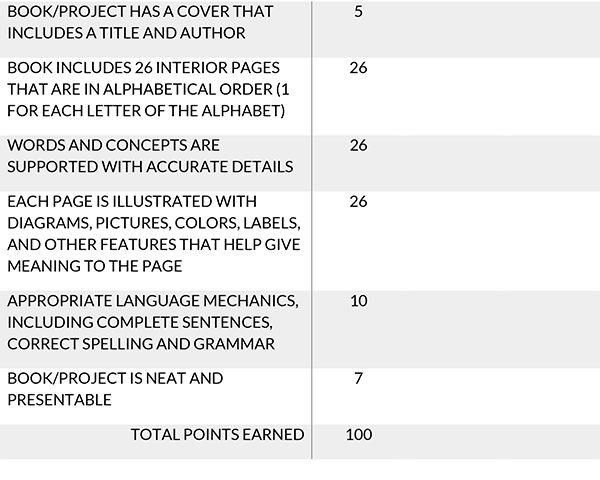
Rubric Template Types
When selecting a template, it is best to use one that can effectively meet the assessment needs at hand. The two common types are analytic and holistic rubrics. Below are the different types of templates:
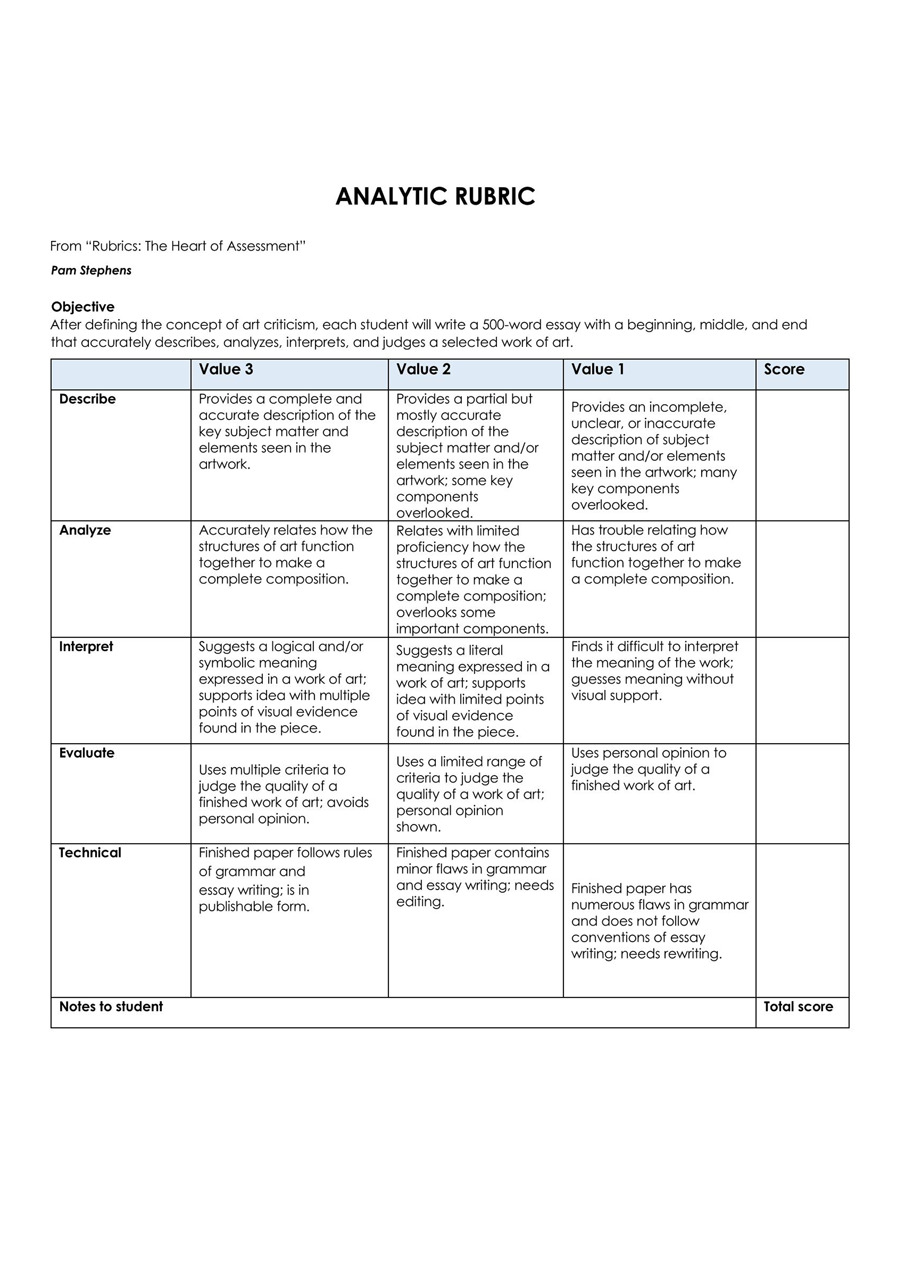
Analytic rubrics evaluate and grade an assignment or work at each performance level. As a result, each performance level gets a separate score which typically requires at least two characteristics of that performance level to be assessed.
Download: Microsoft Word (.docx)
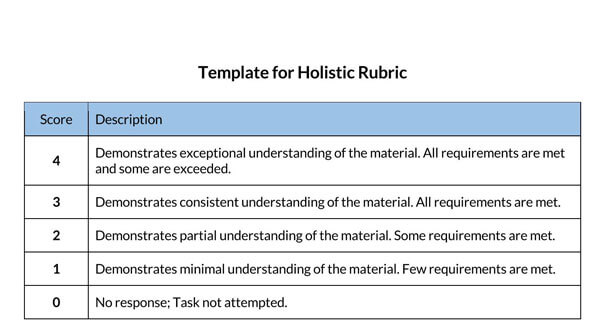
A holistic rubric provides a generalized assessment and score for the assignment. It gives the overall student's or employee's performance based on all the criteria assessed. Holistic rubrics are suited for quick assessments and large group scoring. However, they are confined in that they are not detailed as they do not show specific performances at each level.
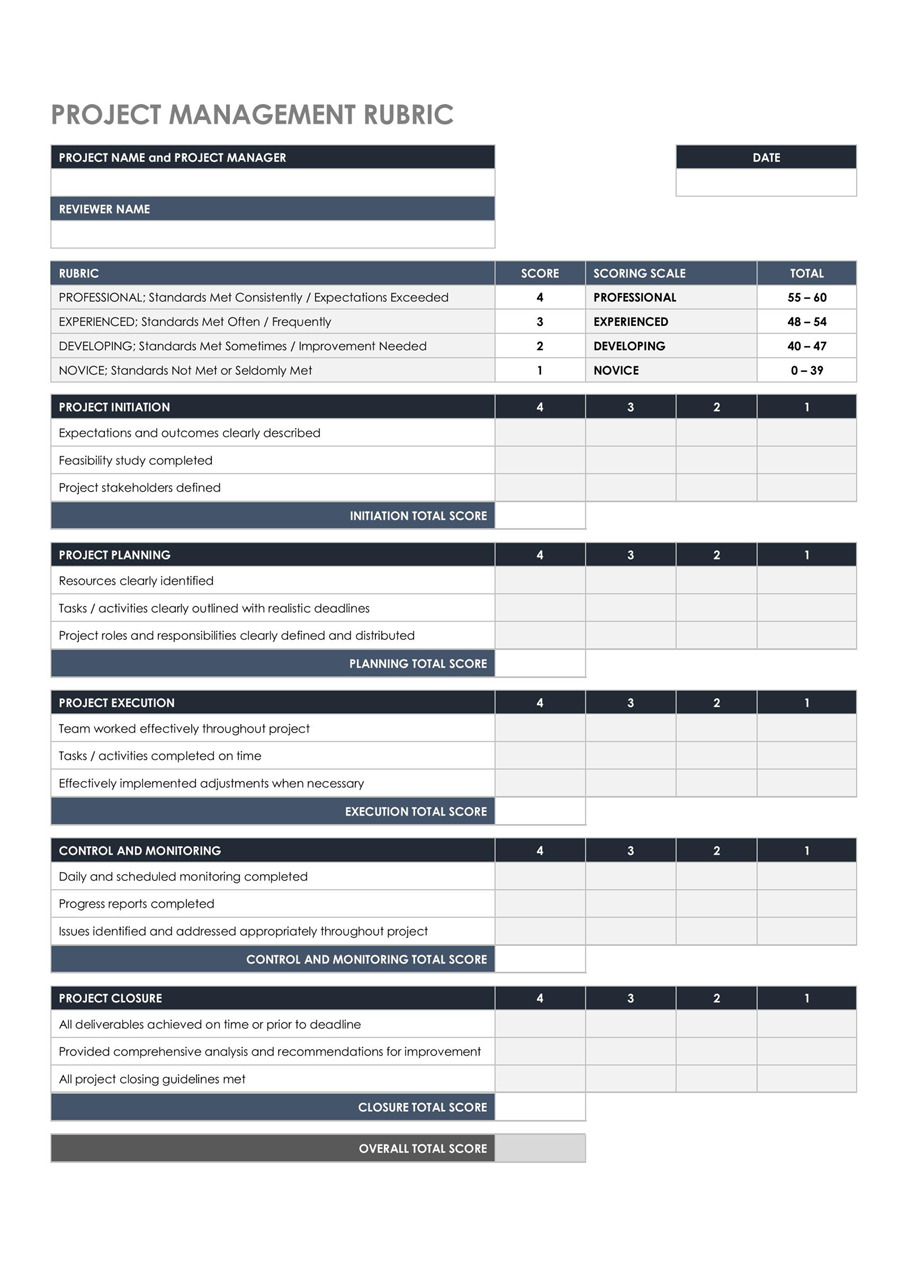
Rubrics are also used in project management to evaluate performance. The criteria used in project management rubrics are project phases, key objectives, and project milestones. The success metrics or indicators of each criterion are then listed as characteristics of levels of performance. A rating scale is used to measure performance.
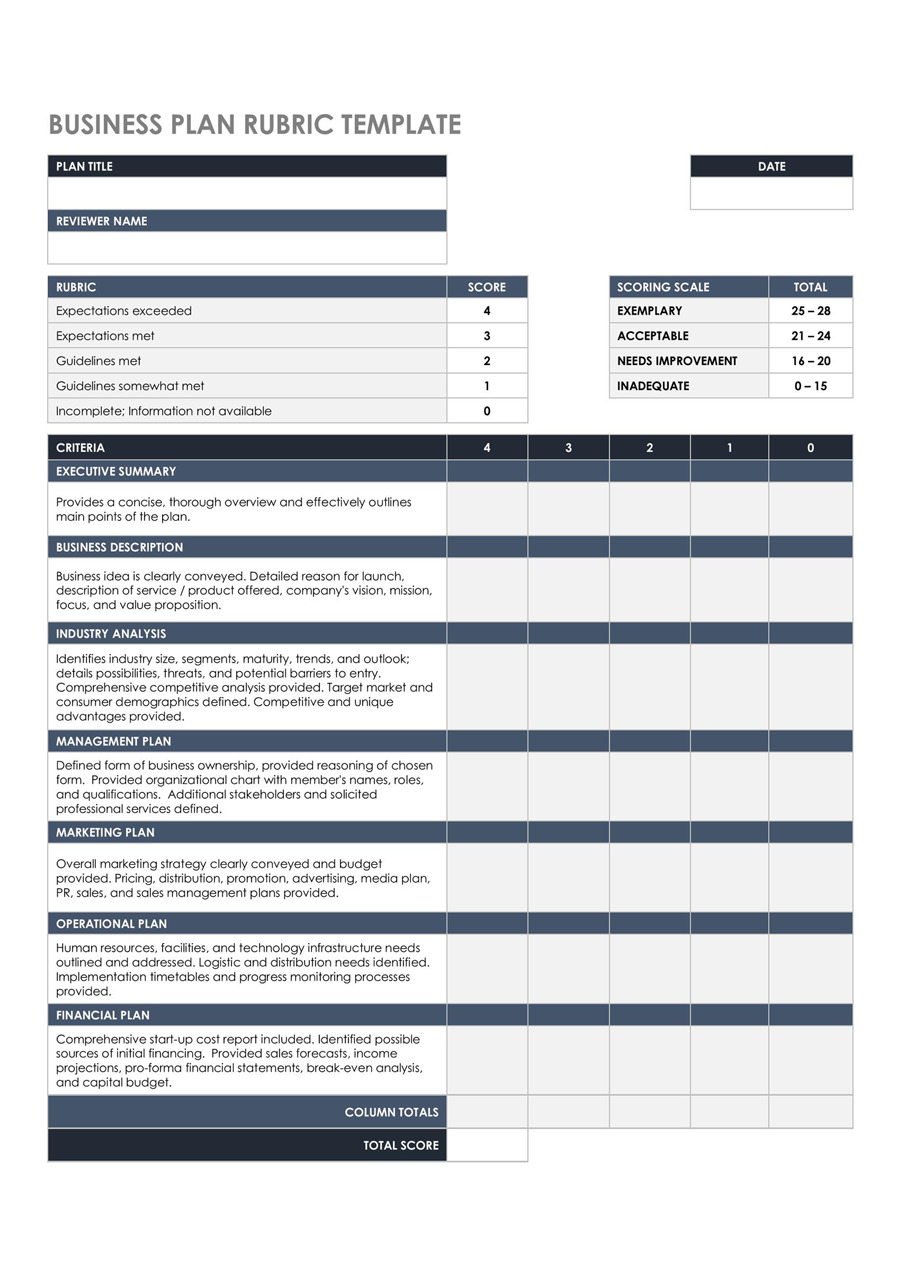
The performance of a business plan can be assessed using a rubrics template. Components of the business plan such as mission statement, market analysis, operational plan, financial plan are used as criteria and are rated based on their quality. A business plan rubric template helps identify the strengths and weaknesses of a business plan before presentation or execution.
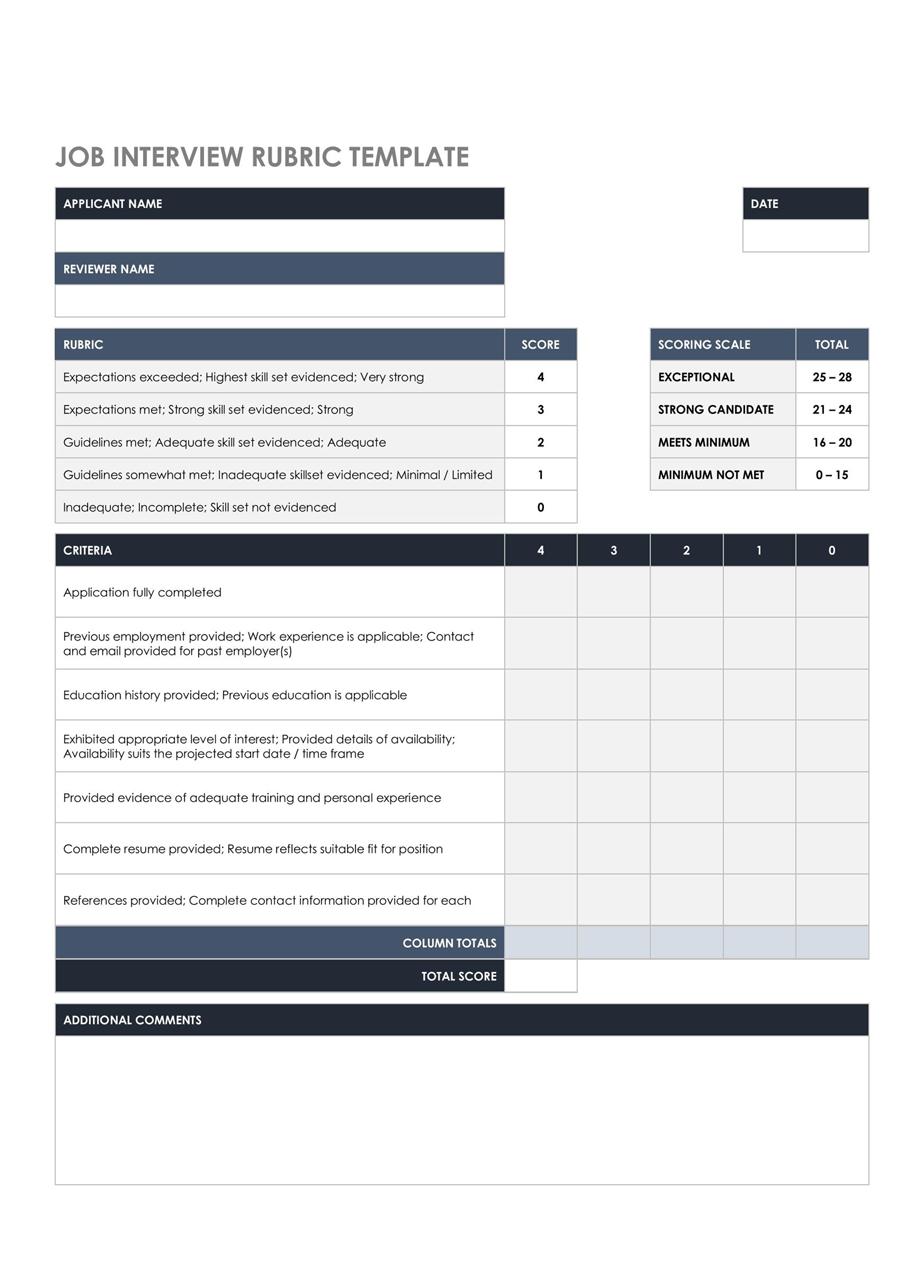
Job interviewers are popularly known to use rubrics to assess and score interviewees. Job qualifications and requirements such as academic qualification, professional experience, skills, and references can be used as criteria for evaluating performance.
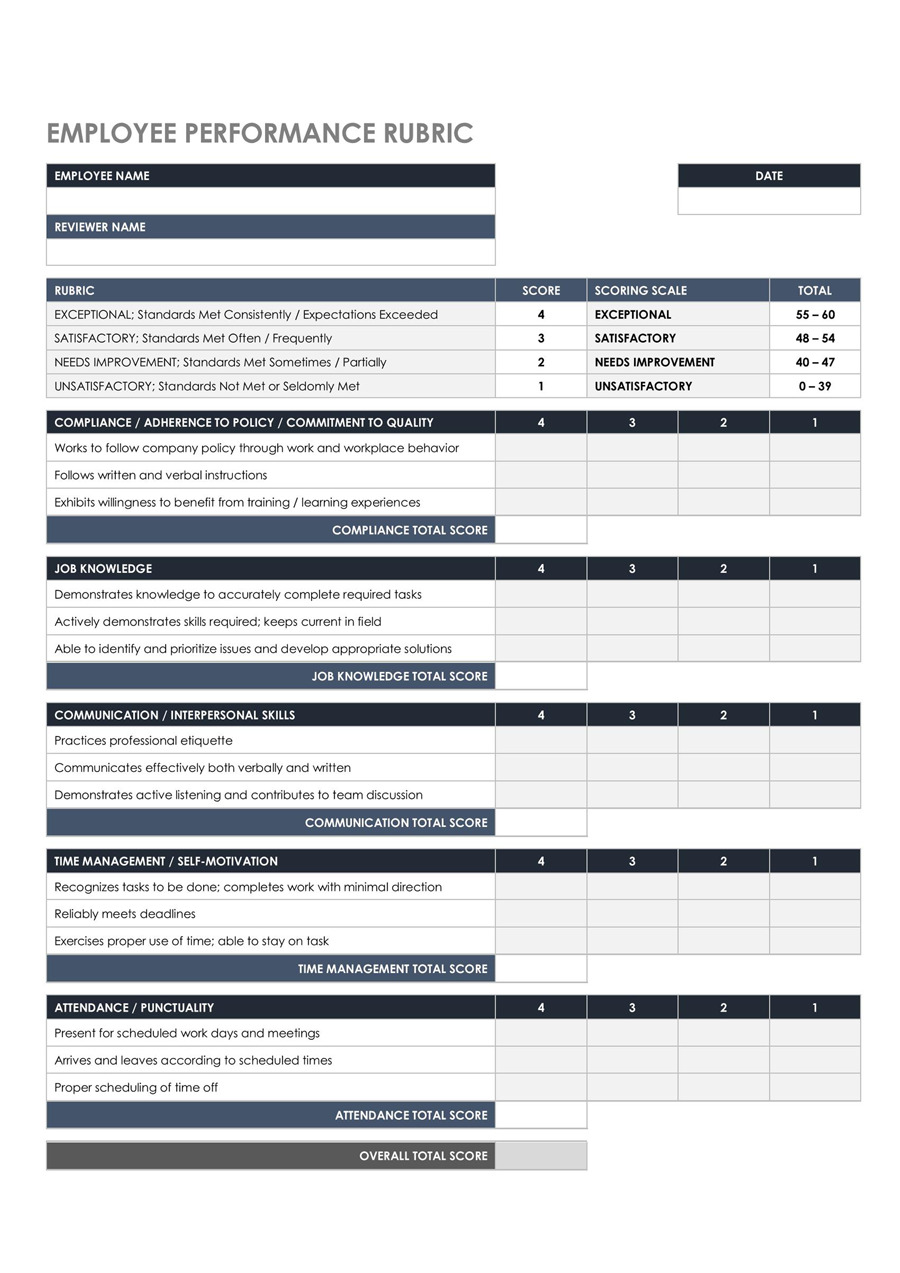
Employee performance assessment is essential for HR management and boosting productivity. An employee performance rubric will take into consideration teamwork, attendance, time management, leadership, and other aspects that influence productivity.
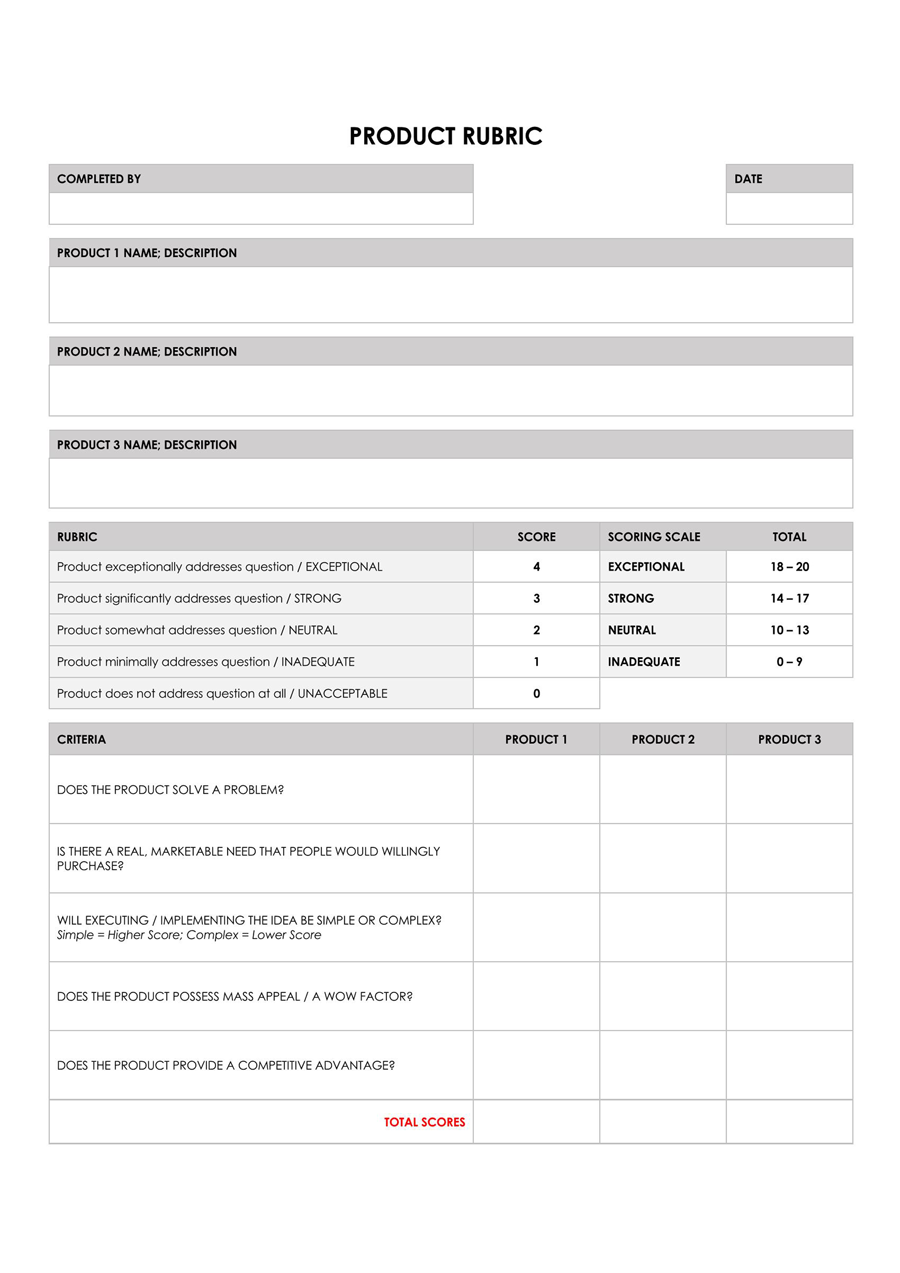
Rubrics can be used in product research and decision-making. A rubric is used to assess how a new product or intended purchase aligns with business objectives. Factors considered when assessing a product are viability, demand, RoI, and other benefits that can be realized by its introduction. The performance of the product can be ranked and compared to those of other products to determine which product is worth investing in, the most beneficial.
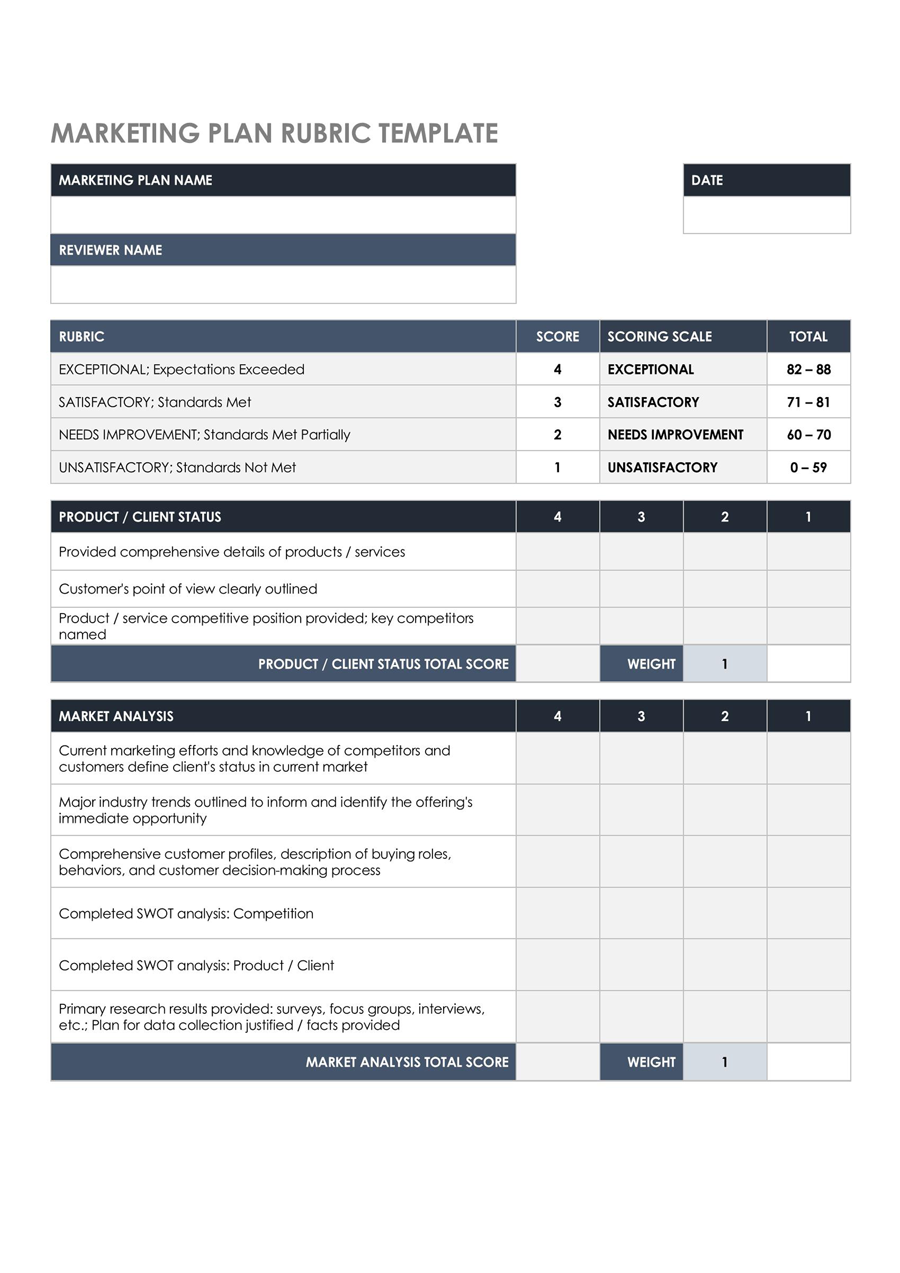
A marketing plan's success depends on multiple factors that can be assessed with a rubrics template. The rubric can evaluate how action items influence results and grade their performance. The overall score of the marketing plan is an indication of its effectiveness and can be used to determine areas of improvement.
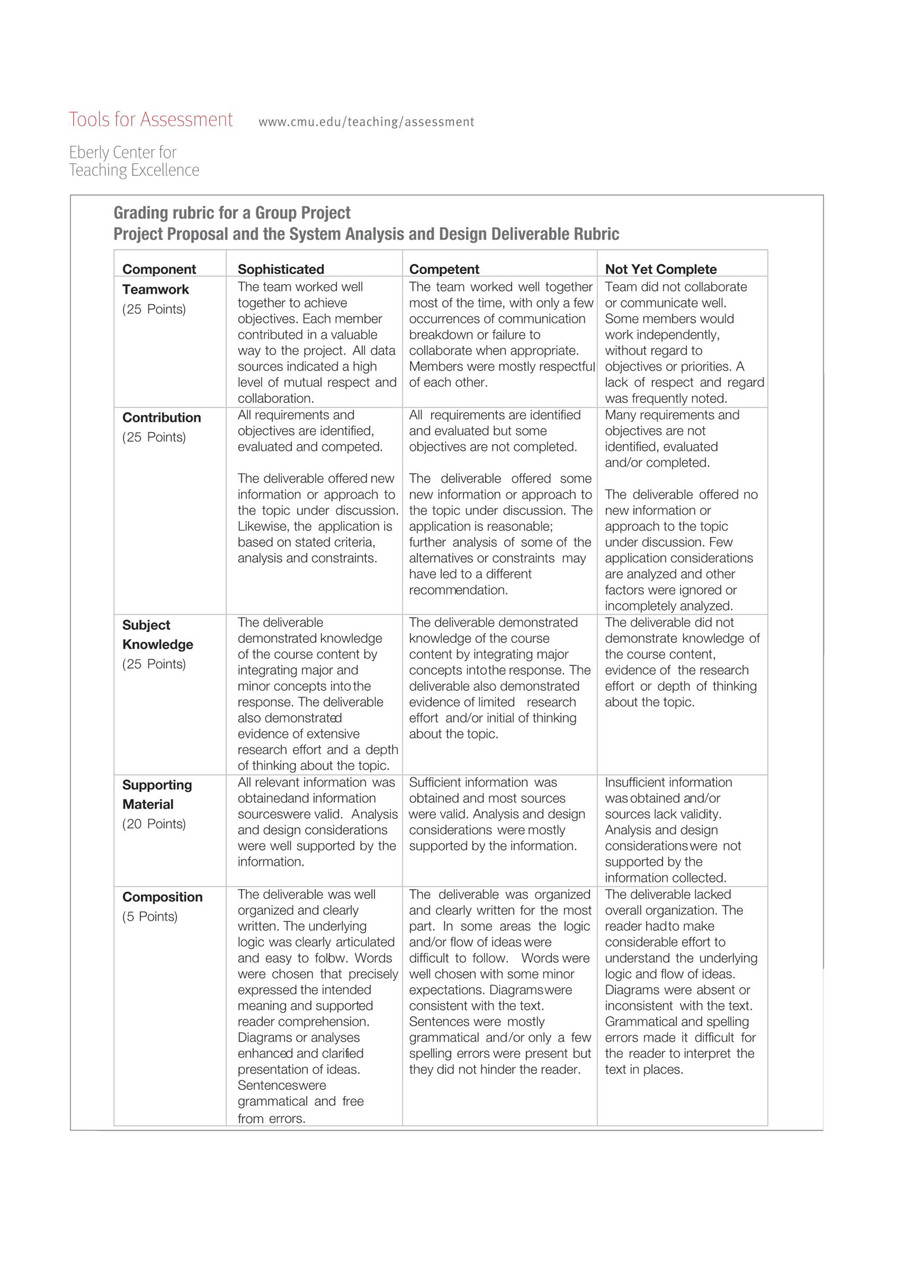
A group project rubric is used to assess the performance of a group of individuals assigned the same task. The rubric considers factors such as teamwork, member contributions, subject knowledge, presentation skills, organization, content, and any other. A group project template is a simple tool for collectively assessing team members.
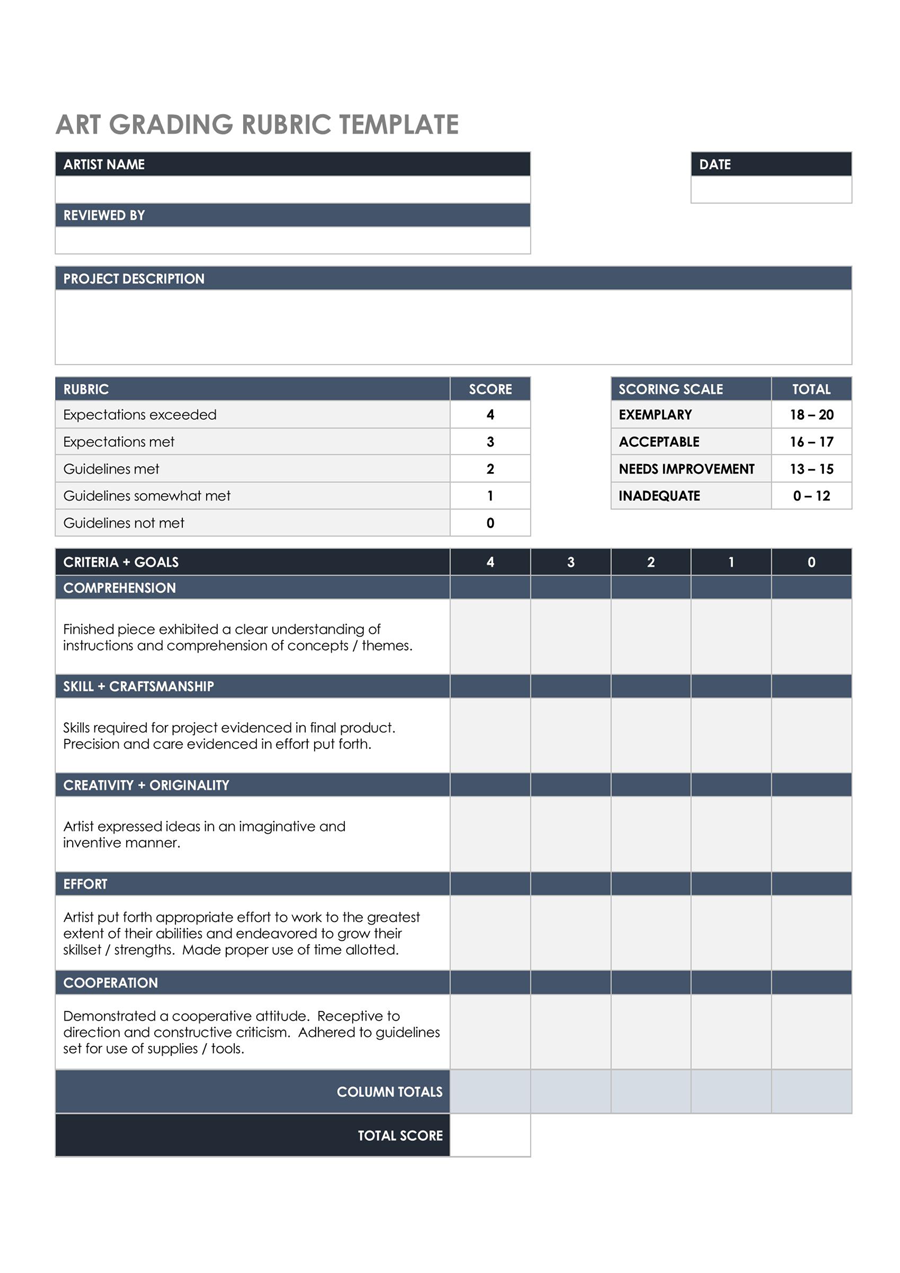
A type of rubric template used for grading art projects. It will cover aspects such as subject comprehension, skill and craftsmanship, originality, creativity, and other criteria that can be used to grade art. This type of rubric template will vary depending on the type of art.
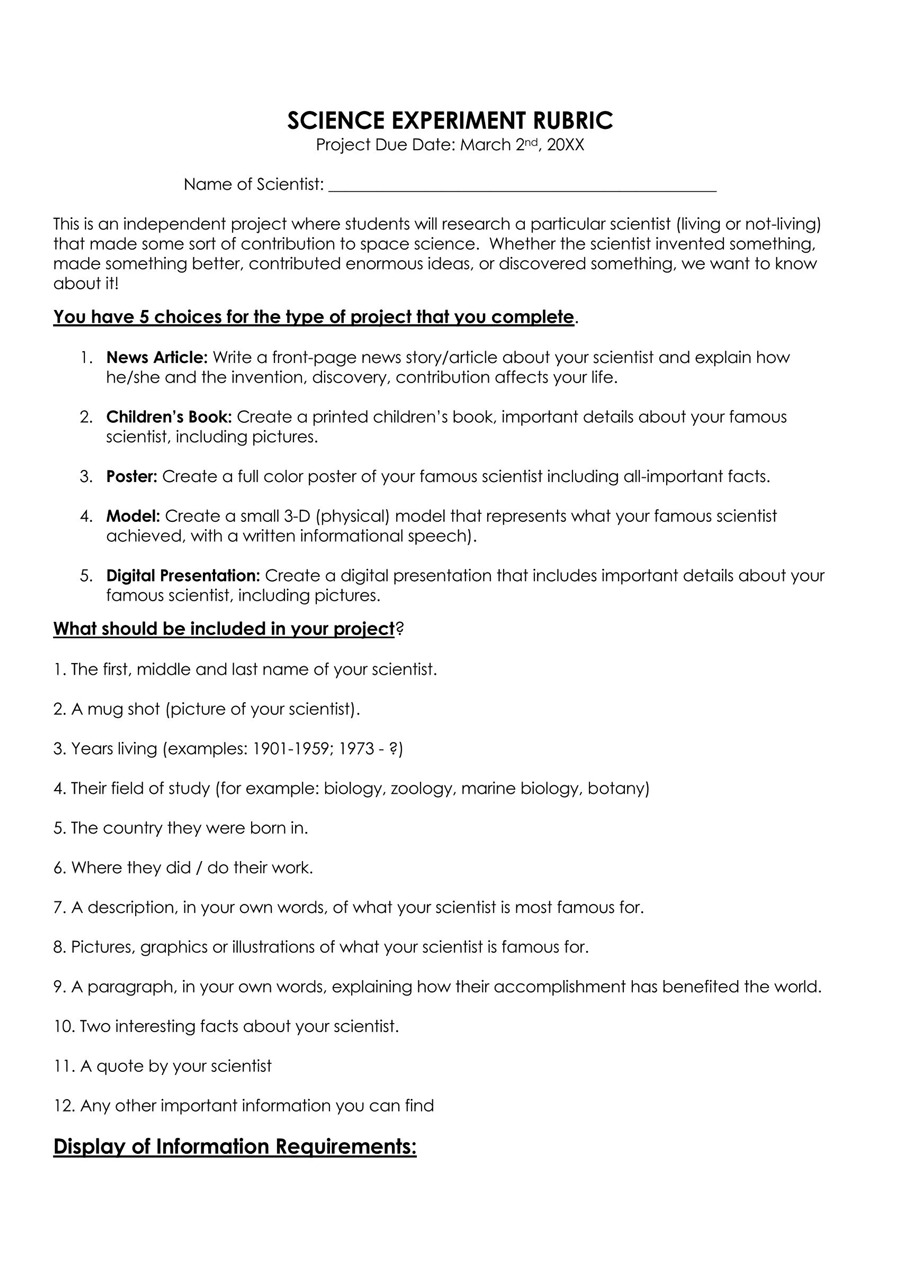
Science projects can be evaluated using rubrics. Examples of factors considered when assessing a science project are experimental hypothesis, design, materials, procedure, data collection, analysis, discussion, and presentation skills.
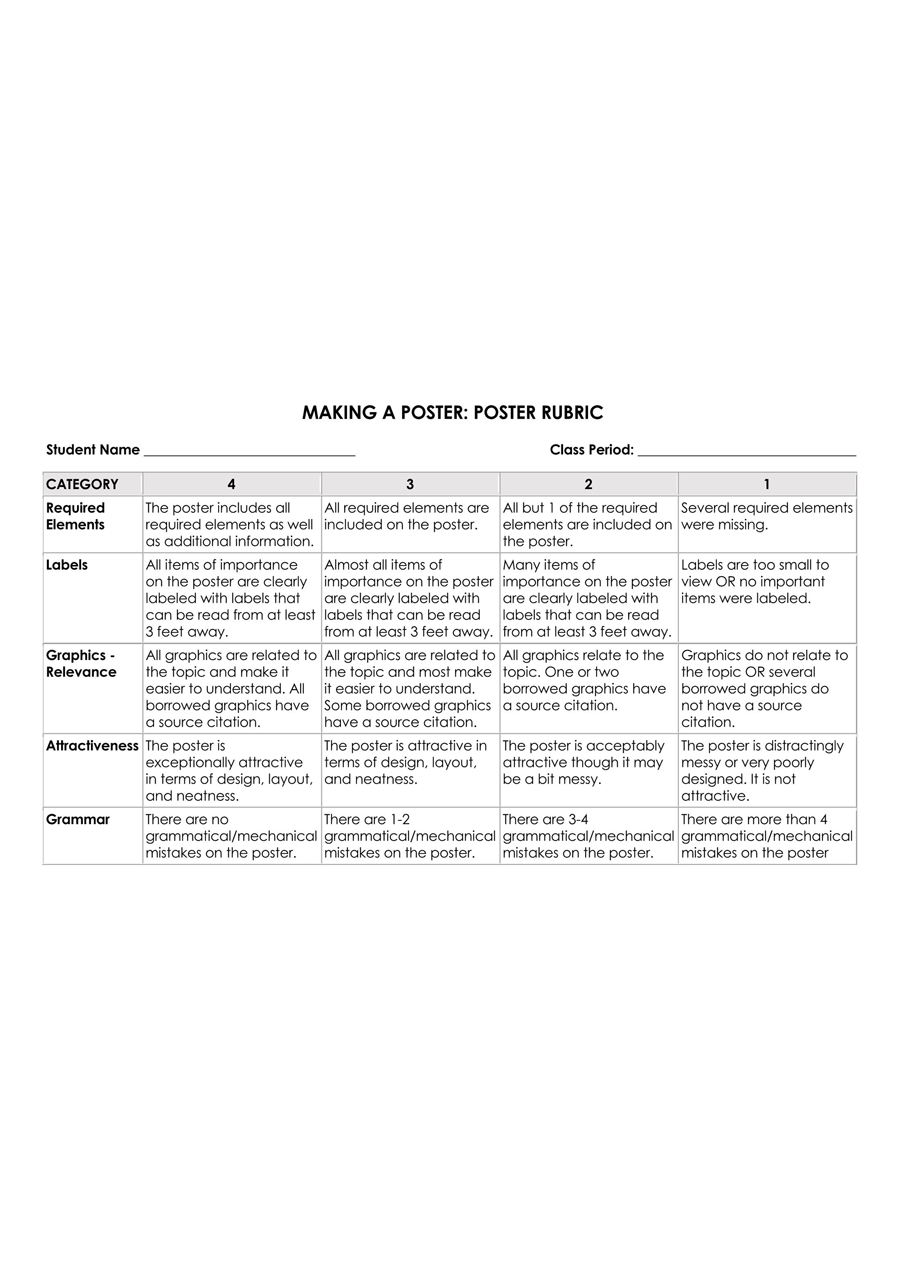
A poster rubric template is used to evaluate poster assignments, commonly utilized in elementary school. Criteria used include required components, graphics used, presentation appeal, creativity, content, and grammar. Students can grade each student accordingly.
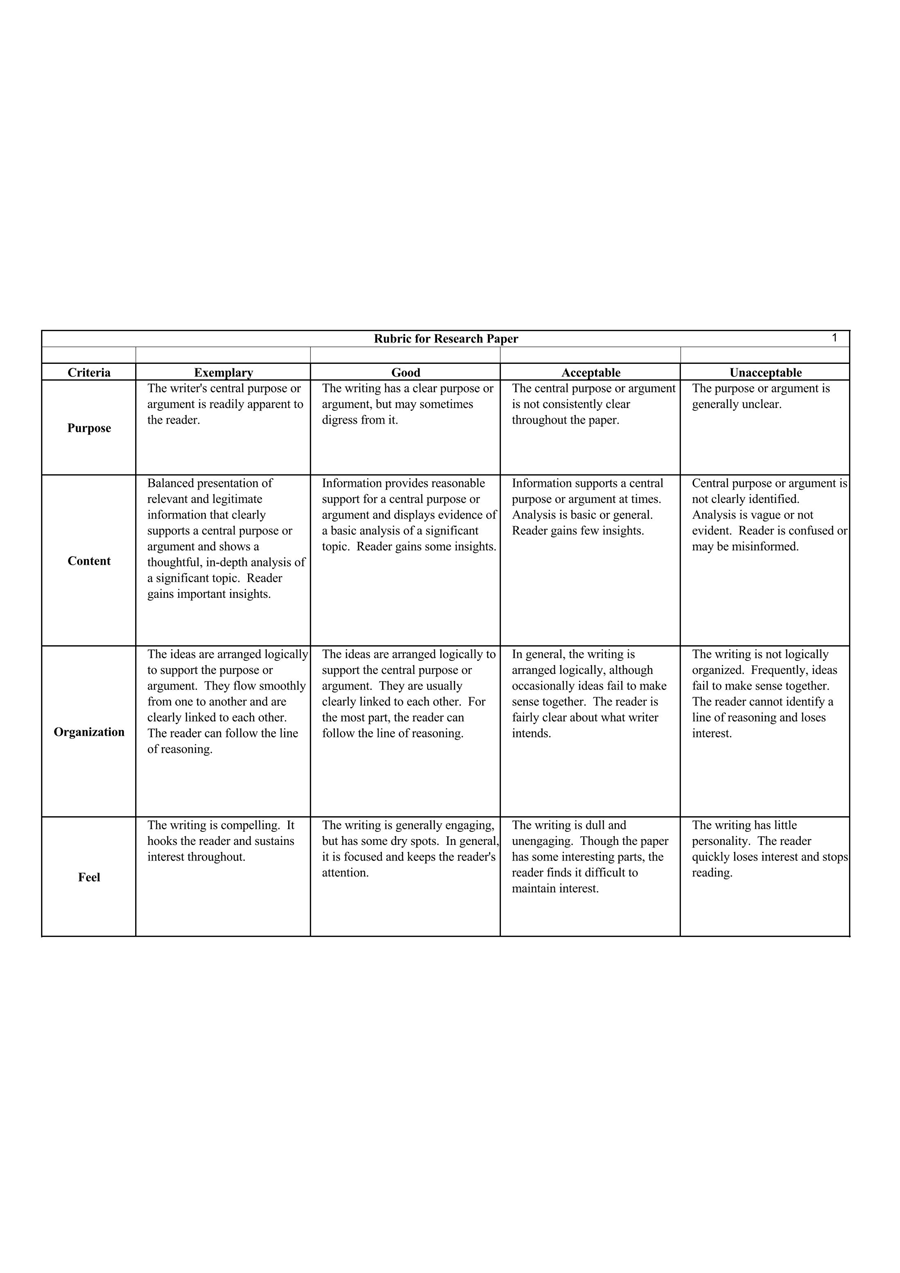
Rubrics can be used to evaluate and score research projects, written reports, and other written assignments such as dissertations, essays, etc. Common criteria used in research project rubrics include objectives, content, format and structure, writing skills, analytical skills, use of references, submission, etc.
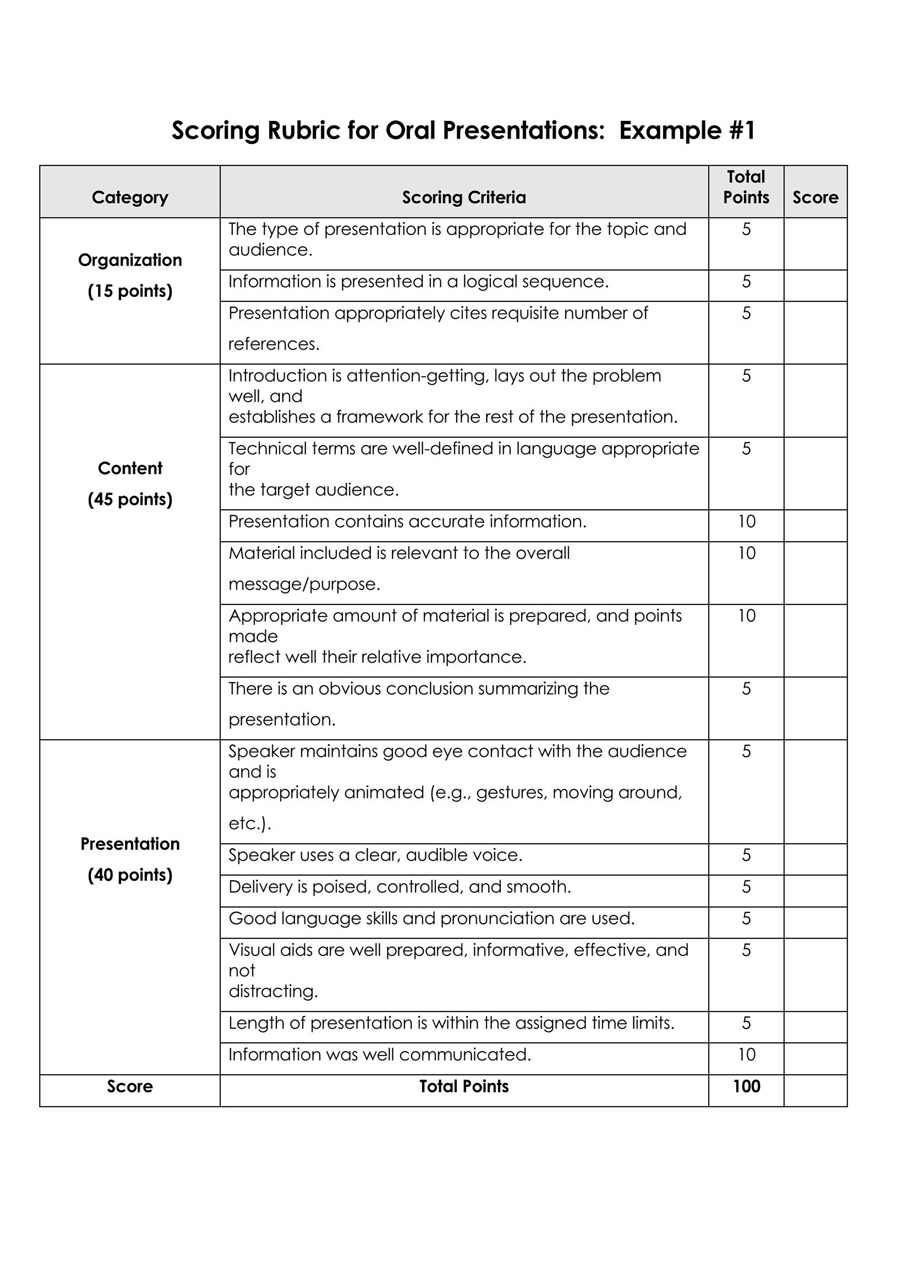
Presentation is a common means of reporting in both academic and business settings. The effectiveness of a presentation can be established through a rubric. Elements of a presentation that need to be assessed are oral communication and presentation skills, delivery, visual elements, organization, supporting material, etc. Rubrics can be used by lecturers, professors, and supervisors to grade presentations.
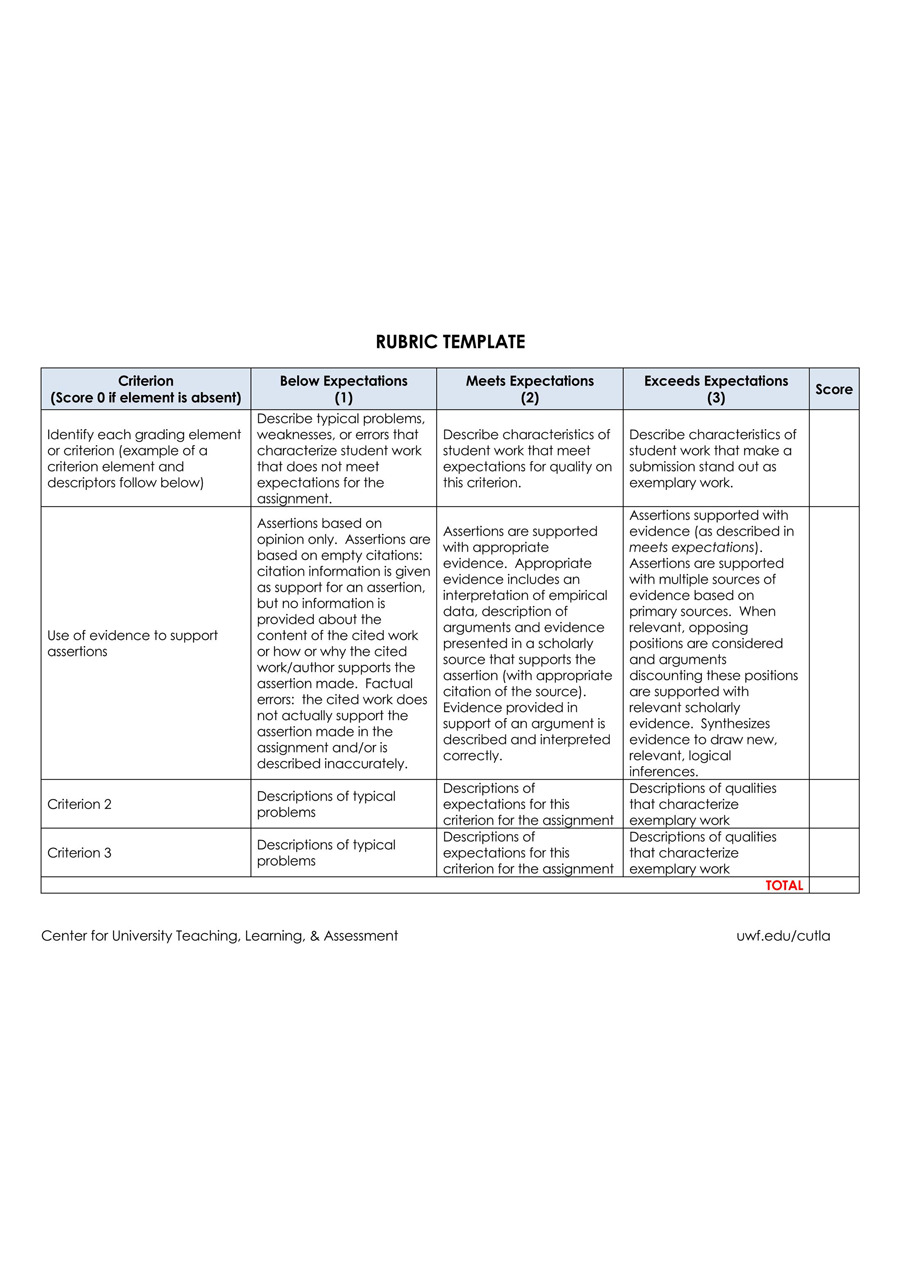
A type of rubric used to assess any type of project, assignment, or work performance. It covers the key elements of a performance success such as comprehension, skill, creativity, effort, cooperation, etc.
How to Create It?
A good rubric template has to be detailed to give an accurate assessment. It must outline all the elements while giving comprehensive descriptors.
Below are the steps for developing a template:
Create a task description
The first step is to identify the tasks or areas of assessment. The task description(s) indicate the actions that the student or employee is expected to complete and will often be influenced by the assessor’s objectives. Factors that determine the task description include the importance of each task, performance assessment procedure, level of feedback expected to be given, performance standards, and grading system to be adopted.
For a teacher, the task could be:
A ten-page book review of Romeo and Juliet.
Identify the criteria (rows)
Next, the assessor should identify the criteria they will use to assess the quality or grade of performance. Criteria are used to assess the student or employee’s level of skills and knowledge; identify at least four criteria and at most 7. Different assignments will have different criteria. Eliminate any non-crucial criteria.
The criteria can be grammar, originality, content, and clarity in the example above.
Determine a performance rating scale (columns)
Afterward, determine the grading system for the rubric template to assess the performance level at each work criterion. A performance rating scale should cover the following three levels of performance:
- Level 1: Level 1 represents the optimal expectations of the assessor. Therefore, the characteristics that describe the best work or meet the assessor’s expectations should be determined.
- Level 2: Level 2 should represent intermediate categories or levels of performance , which can be more than one. A description of the characteristics of these levels should be determined.
- Level 3: The last category of performance level should give characteristics of an unacceptable level of performance.
The performance rating scale can be given as; ranks such as numbers (1, 2, 3, 4) or grades (A, B, C) or as descriptors such as excellent, good, satisfactory, and needs improvement. The example given earlier can use these descriptors. Each character and definition of the performance levels should be mutually exclusive.
As a result, an even number of performance levels should be used to avoid categorizing levels with cross-over characteristics and descriptions. Performance levels should be supplied in the columns and must follow an order, preferably best to worst.
Write a description for each performance level
The assessor should then provide short, measurable, and specific descriptions or statements for each performance level. The description should be able to assess and categorize assignments that are being assessed. Ensure the template is limited to one page to make it easier to use.
Test rubric
The template is then tested by applying it to an assignment and sharing the assessment results with colleagues. Have them evaluate how effective the rubric is in grading performances based on shared organizational grading systems and shared expectations.
Get feedback and revise
Once feedback is obtained, review the template and incorporate any improvements required or remove any notable issues.
Smart Tips to Develop a Good Rubic
How well a rubric is developed influences the accuracy of its results (scores). Below are essential tips to keep in mind when creating one:
- Find and adapt an existing rubric: Due to the divergent expectations of different assessors, it is rare to find an existing one that highlights all the expectations of a project or assignment. While a project-specific can be created, it may take time. Therefore, it is always best to look for a closely resembling rubric, maybe from a colleague, and modify/adapt it to fit the situation.
- Evaluate the template: Review the template to add or remove. An effective one must relate to the assessor’s expectations and be feasible for the project. Irrelevant elements should be removed.
- Collect samples of student work: Collect samples of the student or employee performance that meet the expectations at each performance level to act as benchmarks or exemplars of quality at the different levels. Samples are essential for highlighting characteristics at different scale levels.
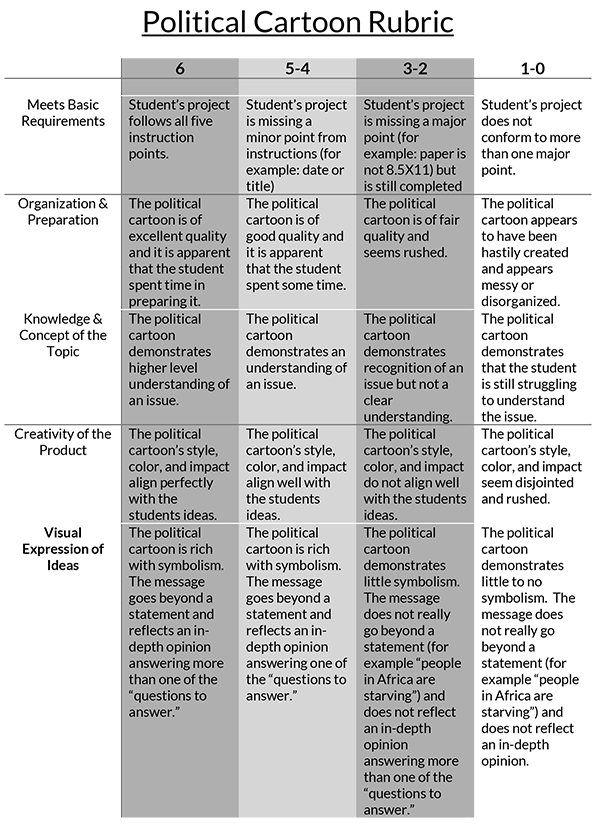
Pros and Cons of It
The use of rubrics has its advantages and disadvantages. This article will look at the pros and cons that teachers and employers should be aware of when assessing the performance of their students and employees, respectively.
One of the merits template is its ability to give feedback to the person being assessed. Feedback is a crucial element in helping students and employees identify their strengths and weaknesses and promoting growth in performance. Students and workers can know the areas that led to a poor assessment report and learn how to improve on these areas.
They promote metacognition development by promoting critical thinking among students and workers. Rubrics justify scores and grades, demonstrating that students earned their awarded grades rather than just being given them. This fosters better performances in the future as the person being assessed becomes aware of what is expected of them.
Rubrics are criterion-based rather than norm-based. This means they assess performance based on the set criteria rather than relativity – conscious or subconscious comparison with other works. By having criteria to measure performance, assessors can make better decisions and limit bias when awarding scores.
Fairness is integral in academics and business. Their use ensures a fixed set of standards is used in evaluating a student’s or employee’s performance. Therefore, regardless of how divergent the student’s or employee’s approach is, it is graded depending on how effectively it satisfies the assessor’s expectations.
There is no standard or fixed scale for rubrics. Assessors can use scales as they see fit, and in some cases, this may compromise its effectiveness. On extreme scales, too few or too many options lead to an ineffective one because too few options do not offer enough details. Too many options are difficult to interpret due to the negligible discrepancies between adjacent options.
They often use inconsistent language that may result in misinterpretations. It is recommended that parallelism and consistency be maintained throughout the description of each performance level.
For example, in a rubric that assesses the relevance of a paper to the topic, the levels can be described as follows:
- Level A – unimportant
- Level B – slightly unimportant
- Level C – moderately important
- Level D – important
The rubric has not used parallelism and consistency due to the combination of unimportant and essential definitions. A better one would be as follows:
- Level A – Least important
- Level B – moderately important
- Level C – important
- Level D – most important
Rubrics that use solid or negative language such as “Not,” “Never,” or “None” to describe poor or low-level performances are known to counter their benefits as they tend to discourage students and workers. The use of slightly, minor, or un- is advocated for.
Sometimes they tend to be vague when defining the characteristics of each performance level. Criteria should be observable and measurable, and how these are achieved should be specified when describing each scale level.
A thesis that is always strong can be characterized as specific, original, and evidence-based. In contrast, a thesis that is usually substantial can be defined as defendable and evidence-based. The characteristic “originality” distinguishes the two without relying on the subjective terms “always” and “usually.”

Key Takeaways
Assessments are necessary for academics and business. A rubric is an effective way of maintaining accurate and consistent student and employee performance records. They also help in offering feedback to the individuals being assessed. Therefore, more than an assessment tool, it is a communication tool between teachers/employers and students/workers.
About This Article

Was this helpful?
Great! Tell us more about your experience
Not up to par help us fix it, keep reading.

Free Printable Car Sale Receipt Templates – Word | PDF

Personal , Planners
Free wedding program templates for word, pdf, and ai.

Employment , Proposals
Writing a job proposal for new job position (free templates).

How to Write Marketing Brief (12 Perfect Examples)
Thank you for your feedback.
Your Voice, Our Progress. Your feedback matters a lot to us.

- Create a Rubric
Tips to Writing a Strong Rubric
Many teachers shy away from rubrics because they are time-consuming to compose. This is true, rubrics CAN take a while to make, but rubrics will save time on the grading end. Quick Rubric makes it easy to set up your rubrics.
Many rubrics can be used again for similar assignments or can serve as templates for new rubrics. Developing rubrics for assignments and assessments helps focus teaching and learning on the most important aspects of content and skills.
To help you write the best rubrics, here are a few tips to get you started.
Decide what you want to grade for this assignment or activity
Before jumping into creating a rubric, think carefully about the performance objectives of the assignment. Keep these objectives specific and clear.
List the most relevant objectives of the assignment. There are likely many aims you have for the assignment (presentation, correctness, organization, vocabulary, etc.), but make sure you are using the criteria that relate to the assignment. What are you trying to assess with THIS assignment? You may want students’ work to be neat, or follow a certain format, but do they need to be graded on it? (Sometimes: yes!)
Choose three to seven criteria that satisfy the objectives. More than seven criteria can be overwhelming for students and teachers alike. Criteria need to be measurable: there needs to be evidence of whether or not students have achieved them. “Understanding” or “knowing” is not easily measured, but what students DO to show their understanding or knowledge can be. Sometimes one criterion will satisfy a Common Core standard, and sometimes there will be several criteria on a rubric that all satisfy the same standard.
Criteria vary greatly on the subject matter and scope of the assignment, but here is a short list of ideas to help.
| Written Assignments | Performance Assignments | Behavior |
|---|---|---|
Decide on a Type of Rubric: Analytical or Holistic?
There are two main types of rubrics: analytical and holistic.
| Analytic | Holistic |
|---|---|
| Gives explicit actionable feedback - shows strengths and weaknesses | Not much actionable feedback |
| More accurate scoring options | Quicker to grade |
| Assess components of a finished piece of work | Overall quality of piece of work (as a whole) |
| Best for assignments with many components, or for targeted feedback | Best for assignments where there are large numbers to grade |
For many of us, we think of analytic rubrics when we hear the word “rubric.” Analytic rubrics list the criteria for an assignment and describe these criteria in varying levels of quality. Most often an analytic rubric is in a grid or table format. The criteria are listed along one side and the performance ratings along the adjacent side. In the example below, the criteria are “Factual Information,” “Use of a Visual,” and “Speaking for a Presentation.”
Different students will perform at varying levels, so it is important to have a range of possibilities for grading, and not simply yes or no, or good or bad. The performance ratings can be either numerical, descriptive, or both. A rubric might divide quality of performance into three parts: 3 - Excellent, 2 - Satisfactory, and 1 - Needs Work. Each criterion needs to be described for each of these performance ratings. What makes the use of a visual “satisfactory” versus “excellent”? The interior of the rubric matches the criteria with the performance ratings for the different shades of merit.
Holistic rubrics are slightly different from a rubric that is set up as an extended grid. A holistic rubric describes the attributes of each grade or level. This type of rubric gives an overall score, taking the entire piece into account, which is particularly useful for essay questions on paper and pencil tests. Most student work will likely fit into more than one category for different criteria. The scorer must choose the grade that best fits the student performance. A holistic rubric scores more quickly than an analytic, and often judges the overall understanding of content or quality of performance. They do not give as detailed feedback on what aspect of the work needs to be improved, so these types of rubrics are less useful for assignments with many components. Math problems for high stakes testing will often use a holistic rubric.
Analytic Rubric Example
Holistic rubric example, determine a reasonable number of performance levels.
Performance levels can be numerical, descriptive, or both. Numerical performance levels lend themselves to easy scoring, just add up the numbers, or let Quick Rubric do it for you! Sometimes, numerical grades do not matter as much, as in a self assessment. Descriptive ratings may be more informative for students to see how well they are performing, and not necessarily what final numerical grade they are receiving.
Three to five performance levels is usually best, but use what works for your assignment. More levels might make it difficult to parse out differences between each. Fewer ratings might not account for enough variance in the quality of the assignments; different quality of work may receive the same rating because there are not enough categories to separate them out. Do you want to have a very variable grading structure, such as 1-5, or are there only a few categories, like advanced, proficient, needs improvement?
Write Explicit Outcomes that Match each Criterion with each Performance Level
What makes for a good answer? Look at each criterion separately. First, write what would satisfy that criterion the best. Then fill in the cell that would get the worst score. After you have your two bookends, go back and fill in the middle. The best part of a rubric is that it shows all the different levels, but the difference between each level needs to be clear, like steps on a ladder, so it is evident why a student received the score he did.
- Use numbers where appropriate
- Use consistent leveling throughout; do not make big jumps between each box for one criterion, and then do incremental steps between others.
- Use descriptive adjectives to differentiate each level
- Include what the performance/product is missing in the middle levels
Finally, Make sure your rubric works. Are you using the correct criteria? Do the best assignments get the best grades? If you have previous student work on the same assignment, test your rubric on a few samples. If that isn’t an option, see how well your rubric stacks up against the student work you receive and revise for future assignments.
Good luck and good assessing!
Empower students to do their best,
Original work, advance learning with an ai writing detection solution built for educators.
Our advanced AI writing detection technology is highly reliable and proficient in distinguishing between AI- and human-written text and is specialized for student writing. What’s more, it’s integrated into your workflow for a seamless experience.
Student success starts here
Uphold academic integrity.
Ensure original work from students and safeguard the value of writing.
Assessments with transparency into AI usage
Flexible solutions enabling educators to design and deliver student assessments their way, while shaping AI-enhanced student writing with integrity and confidence.
Foster original thinking
Help develop students’ original thinking skills with high-quality, actionable feedback that fits easily into teachers’ existing workflows.
Customer stories
University of leeds widely adopts gradescope for online assessment.
With campuswide digital transformation in mind, rollout to thousands of faculty across disciplines took only two months, far quicker than anticipated.
University of Maryland Global Campus builds a culture of academic integrity by pairing policy with technology
Keeping student and instructor needs at the core is key to upholding their rigorous standards of integrity while centering students in their learning.
Solutions made just for you
See solutions for higher education.
Prepare students for success with tools designed to uphold academic integrity and advance assessment.
See solutions for Secondary Education
Help students develop original thinking skills with tools that improve their writing and check for similarities to existing works.
See solutions for Research and Publication
The rigorous academic research and publishing process gets a trusted tool to ensure the originality of scholarly work.
Keep integrity at the core of every assessment.
Everything you need no matter how or where you assess student work.
Feedback Studio
Give feedback and grade essays and long-form writing assignments with the tool that fosters writing excellence and academic integrity.
Originality
Check for existing as well as new forms of plagiarism - from text similarity and synonym swapping to contract cheating, AI writing, and AI paraphrasing.
Grade paper-based, bubble sheet, and code assignments faster than ever while giving more robust feedback and gaining valuable insights.
Address potential gaps in curriculum and assessment to prepare students for their careers and meet accreditation requirements.
This robust, comprehensive plagiarism checker fits seamlessly into existing workflows.
iThenticate
Screen personal statements for potential plagiarism and ensure the highest level of integrity before matriculation.
The Turnitin difference
Complete coverage.
Your coverage is comprehensive, with the largest content database of scholarly content, student papers, and webpages.
Extensive Support
Have the help you need with 24/7 tech support, curricular resources created by real educators, and customized training and onboarding services.
Human-Centered AI
Our people-centered approach to artificial intelligence improves academic integrity and makes assessment better for all.
Unparalleled Access
Access Turnitin tools at scale through integrations with over 100 systems in the educational ecosystem.
Further Reading
The Plagiarism Spectrum 2.0 identifies twelve types of unoriginal work — both traditional forms of plagiarism and emerging trends. Understanding these forms of plagiarism supports the development of original thinking skills and helps students do their best, original work.
An educator guide providing suggestions for how to adapt instruction when faced with student use of AI.

IMAGES
VIDEO
COMMENTS
Benefits of Using Writing Rubrics. Writing rubrics offer many advantages: Clarity: Rubrics clarify expectations for students. They know what is required for each level of performance. Consistency: Rubrics standardize grading. This ensures fairness and consistency across different students and assignments. Feedback: Rubrics provide detailed ...
15 Helpful Scoring Rubric Examples for All Grades and Subjects. In the end, they actually make grading easier. By Jill Staake, B.S., Secondary ELA Education. Jun 16, 2023. When it comes to student assessment and evaluation, there are a lot of methods to consider. In some cases, testing is the best way to assess a student's knowledge, and the ...
Rubric Best Practices, Examples, and Templates. A rubric is a scoring tool that identifies the different criteria relevant to an assignment, assessment, or learning outcome and states the possible levels of achievement in a specific, clear, and objective way. Use rubrics to assess project-based student work including essays, group projects ...
GRADING RUBRIC FOR WRITTEN ASSIGNMENTS. Exceeds Expectations. Central idea is well developed; clarity of purpose clearly exhibited throughout paper. Abundance of evidence of critical, careful thought to support main ideas, evidence and examples are vivid and specific, while focus on topic remains tight, ideas work together as a unified whole.
A writing rubric is a clear set of guidelines on what your paper should include, often written as a rating scale that shows the range of scores possible on the assignment and how to earn each one. Professors use writing rubrics to grade the essays they assign, typically scoring on content, organization, mechanics, and overall understanding.
Example 1: Philosophy Paper This rubric was designed for student papers in a range of courses in philosophy (Carnegie Mellon). Example 2: Psychology Assignment Short, concept application homework assignment in cognitive psychology (Carnegie Mellon). Example 3: Anthropology Writing Assignments This rubric was designed for a series of short ...
For example, this rubric refers to an assignment where students contributed to an online discussion board. As you can see, the assessment can be indicated in various ways—as a letter grade, as a descriptive word or phrase, or as a numerical rating. ... Some instructors opt to return each writing assignment with the rubric attached ...
Task-specific rubrics are written to help teachers assess individual assignments or genres, whereas generic rubrics are written to help teachers assess multiple assignments. Begin by listing the important qualities of the writing that will be produced in response to a particular assignment. It may be helpful to have several examples of ...
Rubrics take a variety of forms, from grids to checklists, and measure a range of writing tasks, from conceptual design to sentence-level considerations. As with any assessment tool, a rubric's effectiveness is entirely dependent upon its design and its deployment in the classroom. Whatever form rubrics take, the criteria for assessment must ...
A rubric is a document that describes the criteria by which students' assignments are graded. Rubrics can be helpful for: Making grading faster and more consistent (reducing potential bias). Communicating your expectations for an assignment to students before they begin. Moreover, for assignments whose criteria are more subjective, the ...
Here is a sample of a rubric with a range of points within each performance level. Step 4: Create a format for the rubric. When the specific criteria and levels of success have been named and ranked, they can be sorted into a variety of formats and distributed with the assignment.
An assignment prompt is a set of instructions for a written assignment. It gives students topics or questions to then address in writing. The assignment prompt gives students a starting point for what to write about, and often provides expectations for the written work. The purpose of the prompt is to provide students with clear understanding ...
Paper Assignments. Example 1: Philosophy Paper This rubric was designed for student papers in a range of philosophy courses, CMU. Example 2: Psychology Assignment Short, concept application homework assignment in cognitive psychology, CMU. Example 3: Anthropology Writing Assignments This rubric was designed for a series of short writing ...
Step One: Identifying Criteria. The first step involved in creating assignment-specific rubrics is revisiting an assignment's intended outcomes. These objectives can be considered, prioritized, and reworded to create a rubric's criteria. If, for example, an instructor assigns a literature review hoping that students might become skilled at ...
Your professor may use a slightly different rubric, but the standard rubric at AUR will assess your writing according to the following standards: A (4) B (3) C (2) D/F (1/0) Focus: Purpose. Purpose is clear. Shows awareness of purpose. Shows limited awareness of purpose.
Assessment Rubrics. A rubric is commonly defined as a tool that articulates the expectations for an assignment by listing criteria, and for each criteria, describing levels of quality (Andrade, 2000; Arter & Chappuis, 2007; Stiggins, 2001). Criteria are used in determining the level at which student work meets expectations.
Holistic scoring is a quick method of evaluating a composition based on the reader's general impression of the overall quality of the writing—you can generally read a student's composition and assign a score to it in two or three minutes. Holistic scoring is usually based on a scale of 0-4, 0-5, or 0-6.
An analytic rubric is a scoring guide used to evaluate performance, a product, or a project. It has three parts: 1) performance criteria; 2) rating scale; and 3) indicators. Using a rubric to evaluate student written work is helpful for both faculty and students. For faculty, rubrics. Rubrics help students to. Benefitting from Rubrics.
Rubrics are a set of criteria to evaluate performance on an assignment or assessment. Rubrics can communicate expectations regarding the quality of work to students and provide a standardized framework for instructors to assess work. Rubrics can be used for both formative and summative assessment. They are also crucial in encouraging self ...
The four-point rubric uses four potential points the student can earn for each area, such as 1) strong, 2) developing, 3) emerging, and 4) beginning. To turn your rubric score into a letter grade, divide the points earned by the points possible. Example: The student earns 18 out of 20 points. 18/20 = 90 percent; 90 percent = A.
Example 1 - Research Paper Rubric. Characteristics to note in the rubric: Language is descriptive, not evaluative. Labels for degrees of success are descriptive ("Expert" "Proficient", etc.); by avoiding the use of letters representing grades or numbers representing points, there is no implied contract that qualities of the paper will ...
Download: Microsoft Word (.docx) Holistic Rubric Template. A holistic rubric provides a generalized assessment and score for the assignment. It gives the overall student's or employee's performance based on all the criteria assessed. Holistic rubrics are suited for quick assessments and large group scoring.
Decide what you want to grade for this assignment or activity. Before jumping into creating a rubric, think carefully about the performance objectives of the assignment. Keep these objectives specific and clear. List the most relevant objectives of the assignment. There are likely many aims you have for the assignment (presentation, correctness ...
Presentational Writing: Yiddish Sample Assignments. In this study guide, two sample assignments are provided to assist an examinee in preparing for the actual test. On the actual test, there will be one Presentational Writing: Yiddish assignment to which the examinee will have to provide a response. Competency 0006 Presentational Writing: Yiddish
the new writing scoring rubric is shared in Appendix A. Phase 2: Internal reviews of the new rubric Following the creation of the first draft of the new writing scoring rubric, it underwent a series of reviews by WIDA and CAL staff, which are described in Table 6. Each of these review phases was conducted by an independent group of reviewers.
Turnitin